What is it like to visit Hälsingland farms? The amazing Hälsingland farms are on the UNESCO World Heritage List, and seven farms have been selected to represent the World Heritage. We decided to visit all seven!
Table of contents
Hälsingegårdar - what is it?
Hälsingegårdar are large historic farms in Hälsingland, sometimes described as 'the proud wooden castles of Hälsingland'. What was special about Hälsingland in the past was that there was no nobility. Instead, there were well-to-do farmers who owned land themselves, and who created a good economy through efficient agriculture and forestry. Flax cultivation in particular contributed to the economy in the 18th and 19th centuries.
What would farmers spend their money on? Building big, beautiful houses was popular, and farmers had access to both forests and labour. In particular, it was popular to build so-called 'feast houses'. These houses were built only for celebrations, especially weddings, and were richly decorated with paintings, stencils, wallpaper and beautiful furniture.
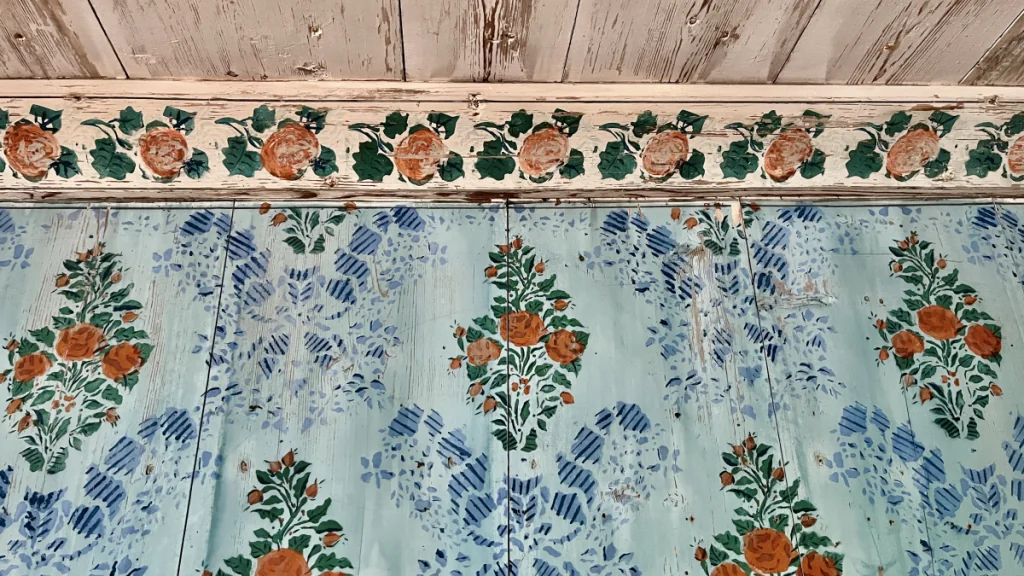
Around 1,000 Hälsingland farms
There are around 1 000 Hälsingland farms, and although some have been rebuilt over the years, many are well preserved. One thing that contributes to their preservation is that the banqueting houses and banqueting halls were only used a few times a year, and were therefore not subject to much wear and tear.
Today, these farms are considered to have such a strong cultural and historical value that seven of the farms have been included on the UNESCO World Heritage List, in the form of the "Decorated Farmhouses of Hälsingland" World Heritage Site.
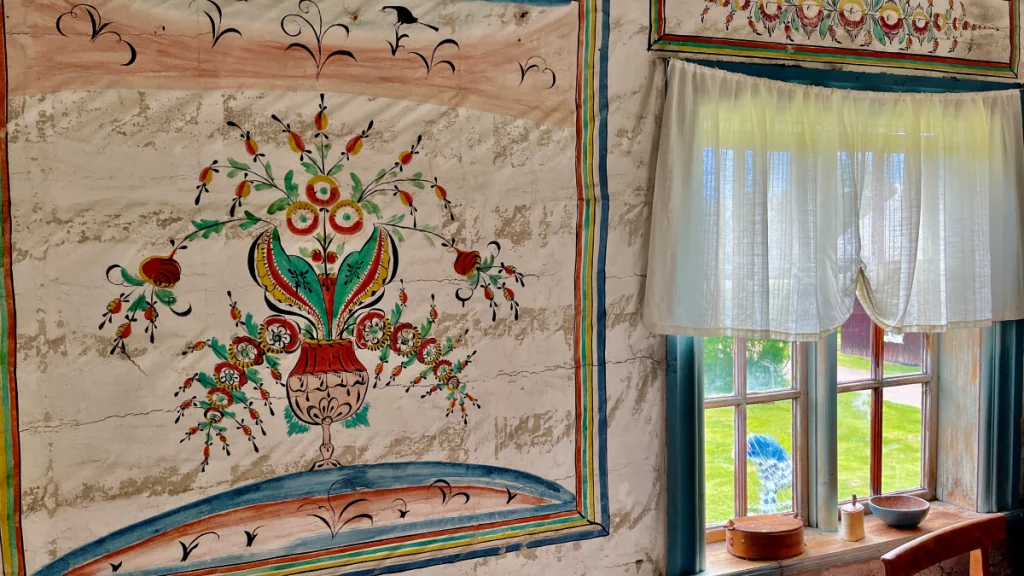
Visiting Hälsingland farms
Hälsingegårds can be visited in different ways. Some are completely private homes and cannot be visited at all, but many have various types of visitor activities such as guided tours, cafés, events and the opportunity to stay at a Hälsingegård.
Visiting the farms on the UNESCO list is very interesting, but it was not as easy as we thought to visit them all. Some of the farms are open to visitors during the summer. Others are run as private farms or residences, and are only open to visitors on a one-off basis, or by appointment.
We found visiting Hälsingland farms incredibly interesting, but sometimes a bit difficult to easily find all the information we were looking for. Now, after visiting all seven on the Unesco list, we have put together a guide!
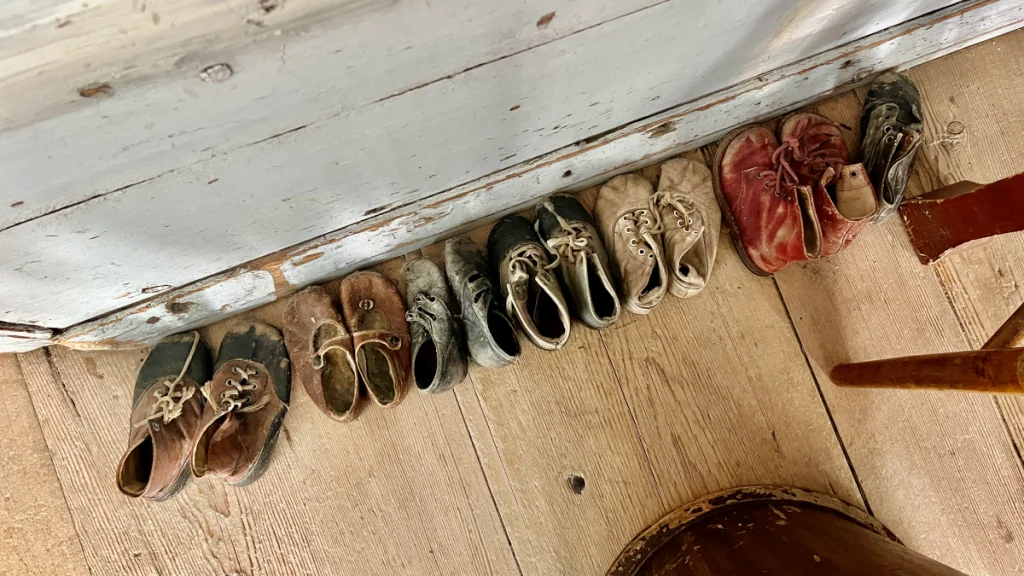
Seven Unesco world heritage sites
So there are a total of seven Hälsingland farms that have been chosen to represent the World Heritage Site. These aren't the only ones worth visiting (there are many others that are fantastic too!) but these have been chosen because they fulfil certain criteria and exhibit various unique characteristics. These are the seven farms on the Unesco list:
- Erik-Anders, Söderala (Söderhamn)
- Guest donors, Vallsta (Bollnäs)
- Kristofers, Järvsö (Ljusdal)
- Bommars, Letsbo (Ljusdal)
- Beyond the river, Loos (Ljusdal)
- Pallars, Alfta (Ovanåker)
- Jon-Lars, Alfta (Ovanåker)
1. Erik-Anders
Erik-Anders is a farm located in Söderala, in Municipality of Söderhamn. This farm is open for much of the summer, and also serves as a visitor centre for the World Heritage Site.
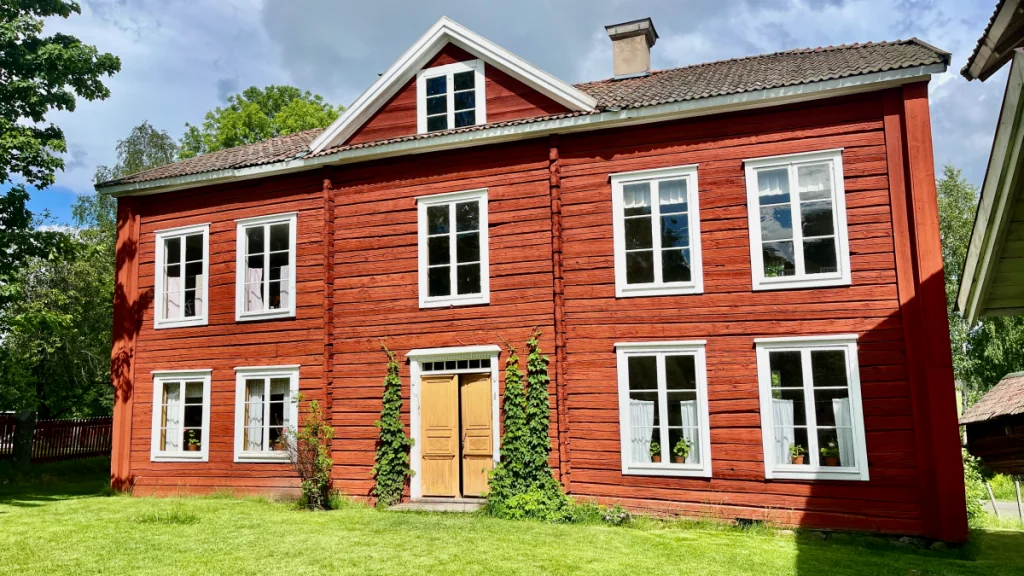
The history of the farm in brief
Hälsingegården Erik-Anders is named after Erik Andersson, who built the farm in the 1820s and had it decorated in the style of exclusive manor houses. Erik was a farmer and councillor in Söderala parish. Today the farm is run privately by the Forssell family.
Especially worth seeing on this farm
The Great Banqueting Hall is considered one of Hälsingland's most beautiful rooms. It has an unusually lavish interior with marbling by the Knutes family of painters. It is also interesting to see furnishings from several different eras, from 1850 to 1950.
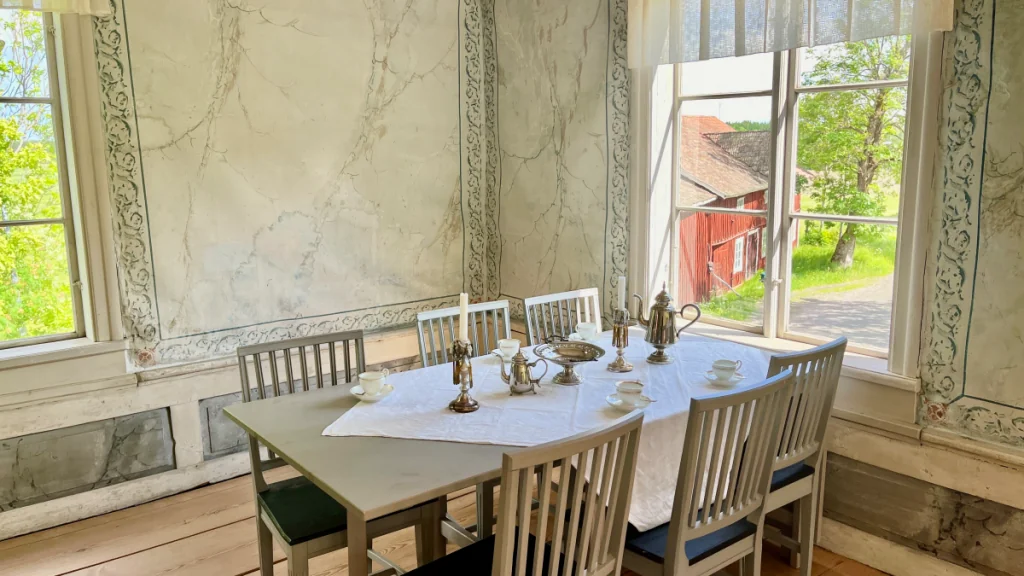
Visiting the farm
Since Erik-Anders is open to the public in the summer, this is an easily accessible farm to visit. We arrived a little too early in the summer for the guided tours, but walked around on our own. It is of course not the same experience to look around without a guide, but it is nice that this opportunity exists when guided tours are not offered.
The rooms are incredibly beautiful and well-preserved, and there is also a café, shop and garden, making Erik-Anders a pleasant place to visit.
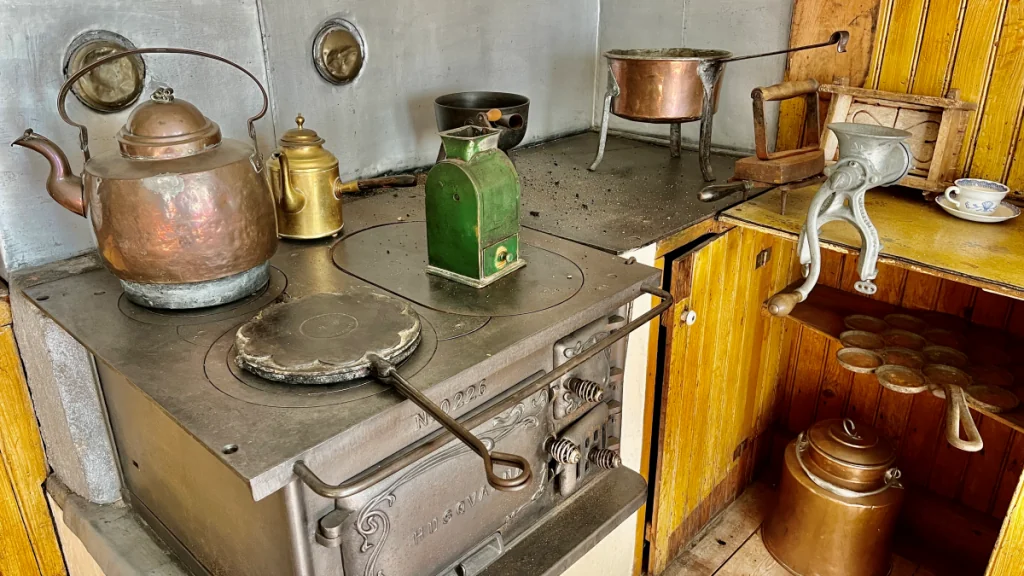
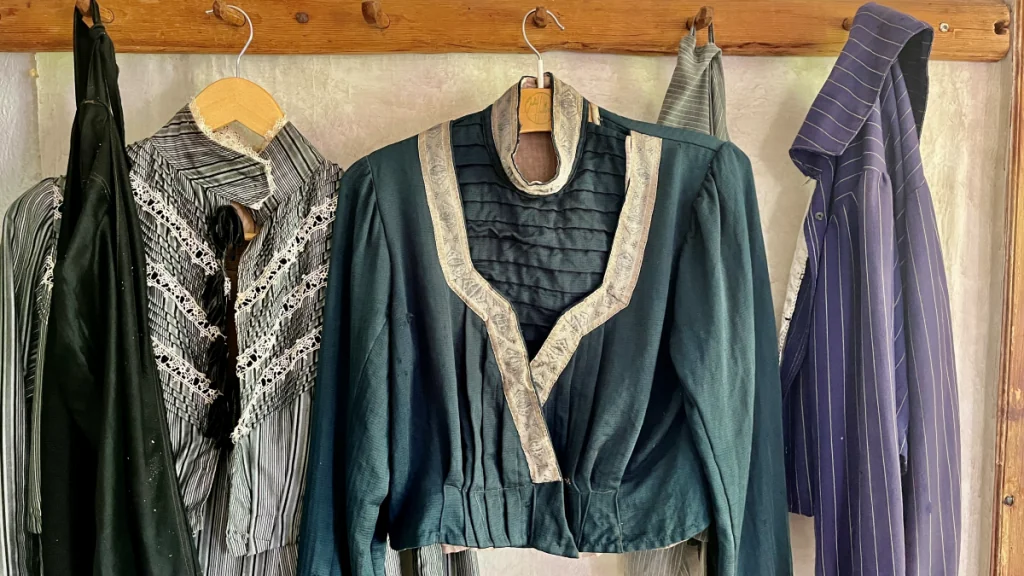
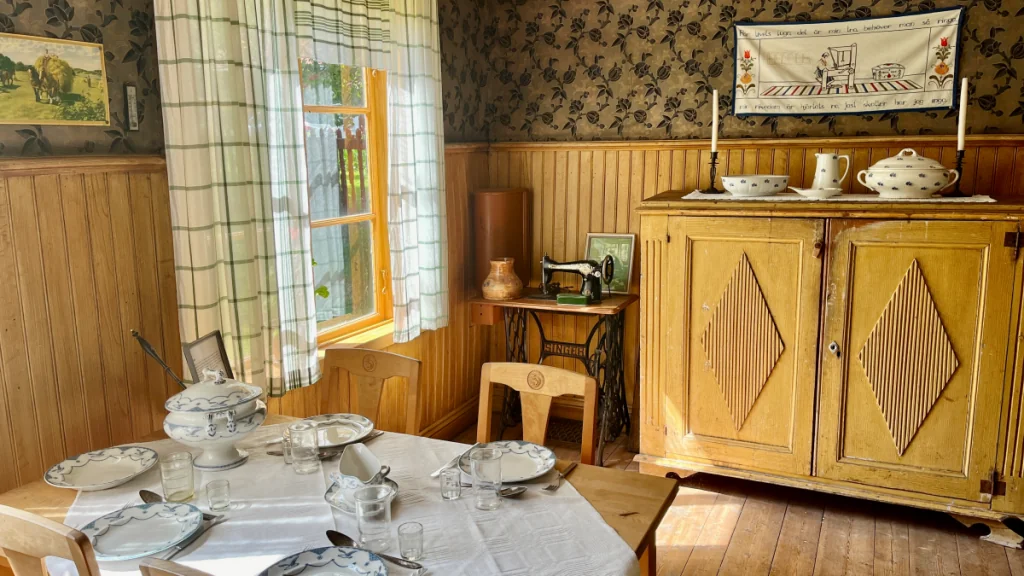
- Address: Asta 728, Söderala (Söderhamn)
- Opening hours: Open to visitors in summer (2024: 22 June - 1 September, open daily 11am-5pm).
- Guided tours: Guided tours are organised during the summer (2024: 22 June - 11 August at 11:00 and 15:00). Group tours can be booked from 1 May to 31 October.
- Price: Self-guided tour: 75 SEK/adult. Guided tour: 200 SEK/adult. Children under 18 years old have free entrance. (These prices are valid in 2024)
- Service: Visitor centre, shop, café, garden, playhouse, accommodation, conference and meetings
- Website: erik-anders.se
2. guest donors
Gästgivars in Vallsta is another beautiful Hälsingland farm that is open to visitors in the summer. Guided tours are also arranged here, and there is a restaurant, shop and visitor centre.
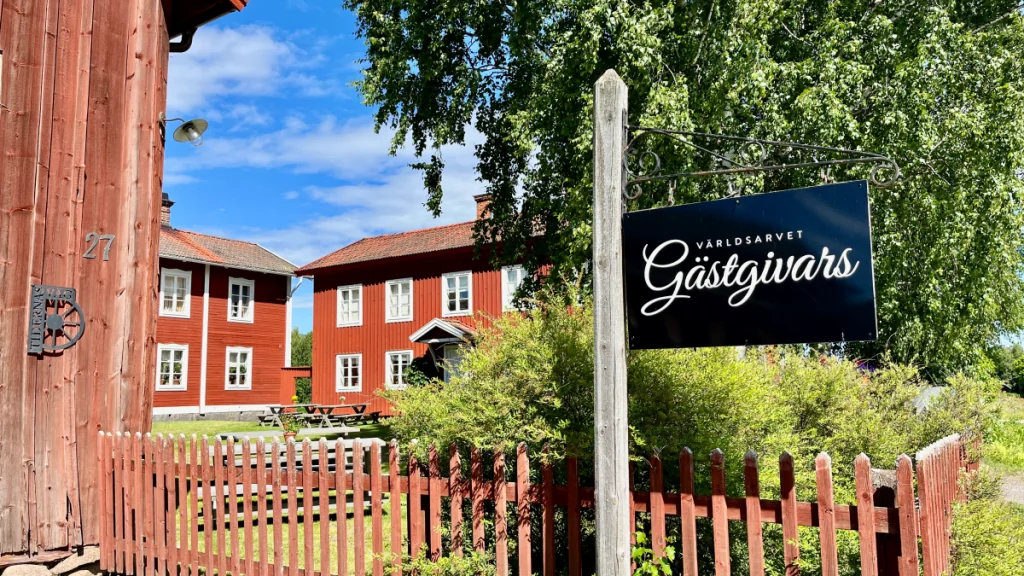
The history of the farm in brief
The village of Vallsta was already inhabited during the Iron Age, and there has probably been a farm on the site since the Middle Ages. The Gästgivars farm was originally built in a closed square, but was later opened up by demolishing one of the houses, following the trend of the time. The name of the farm comes from the fact that an inn was run here in the 17th and 18th centuries. The banqueting house was built in 1838, with parties as its sole purpose.
Especially worth seeing on this farm
The upper men's room in the banqueting house is the finest room on the estate, with beautiful stencilled patterns and borders that imitate gilded mouldings. At Gästgivars you can see fantastic stencils, painted by the prominent and style-forming artist Jonas Wallström. This is also where one of Sweden's most beloved wallpaper patterns comes from: Gästgivarstapeten.
Although the stencils here are very skilfully made, you can find some 'deliberate errors', made because you were superstitious. Only God is perfect and you don't want to measure up to him - so it was considered wise to add a few small errors here and there.
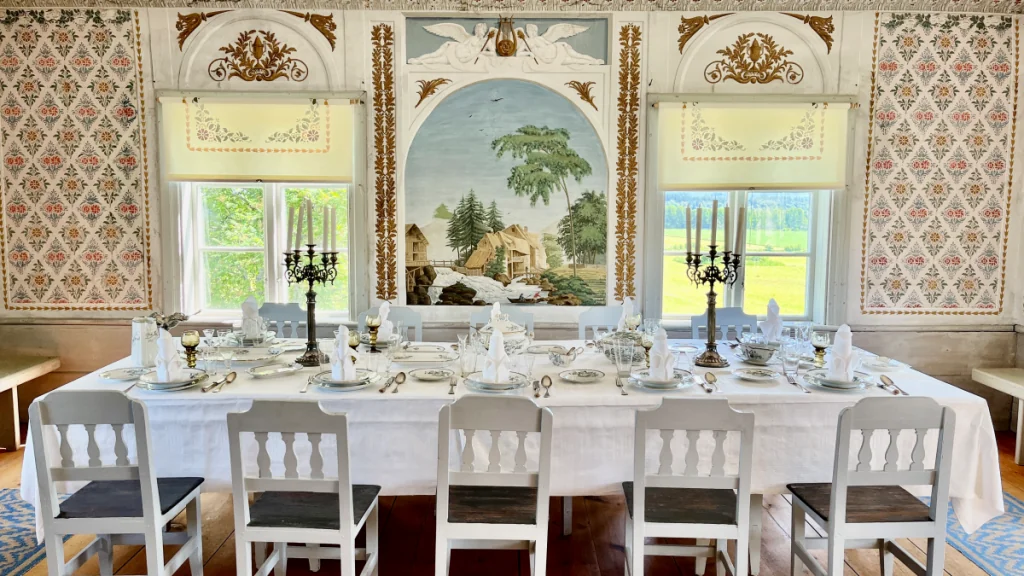
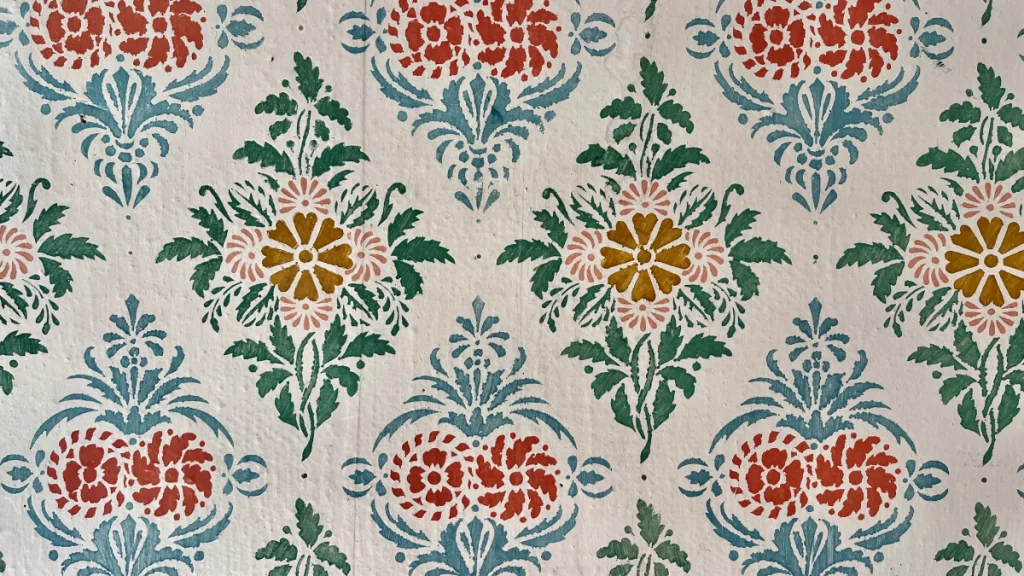
Visiting the farm
Gästgivars is another farm that has general opening hours during the high season, which makes this farm quite easy to visit. To see the farm, you have to take a guided tour, which is very interesting. The farm is very beautiful and well preserved, and there is also a café and a cosy little shop, making it a great place to visit.
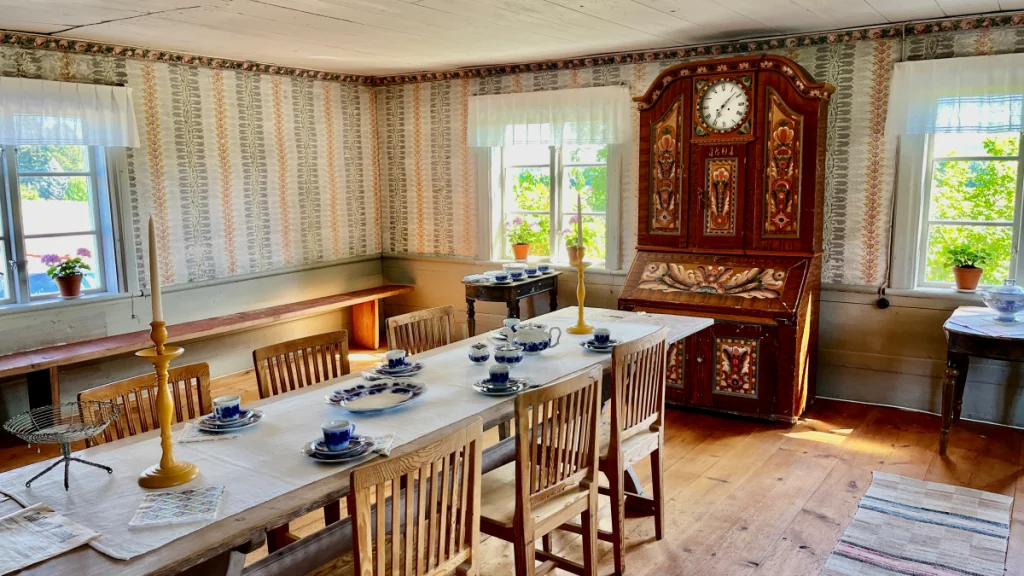
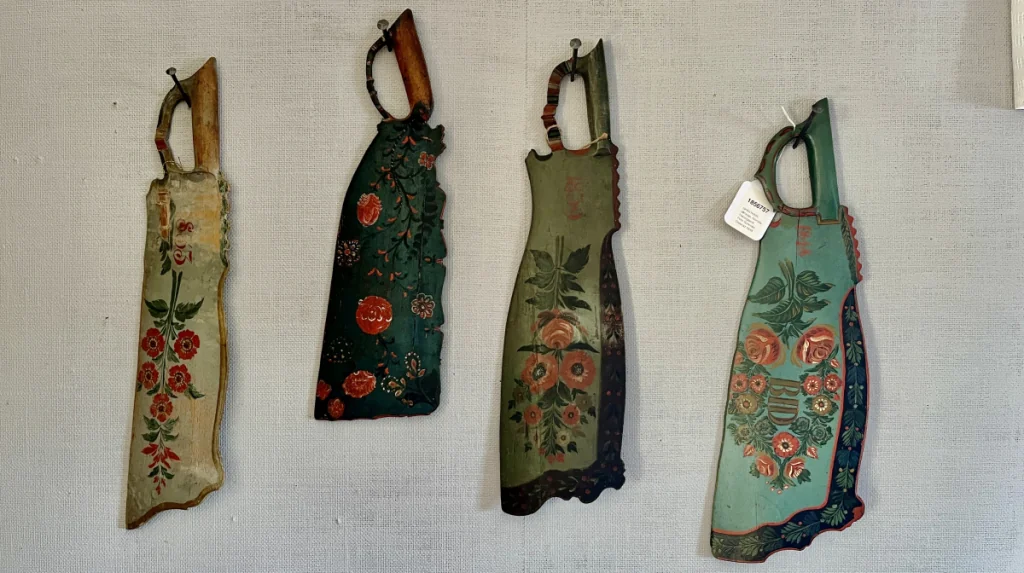
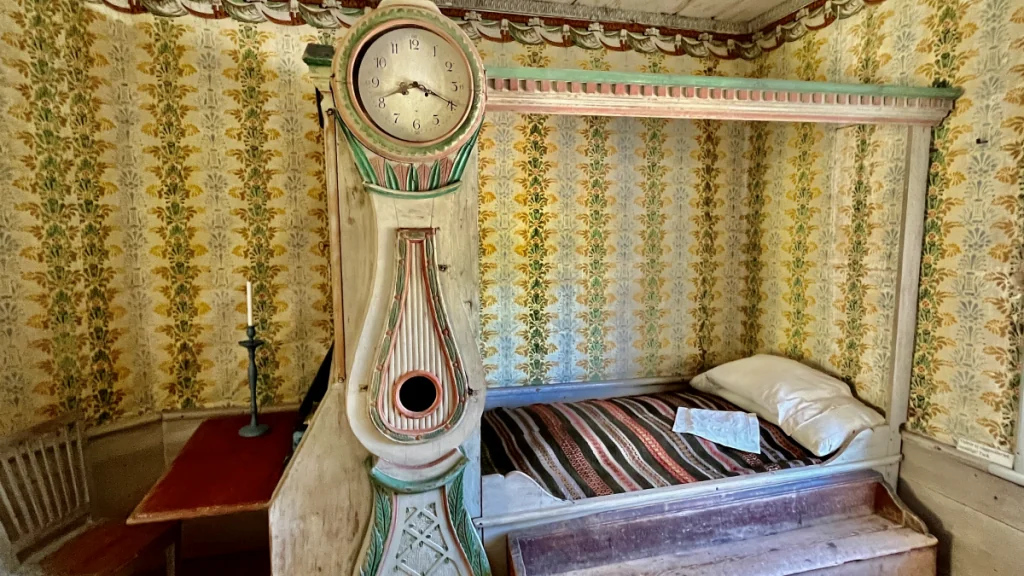
- Address: Gamla Orbadenvägen 29, Vallsta
- Opening hours: Open to visitors in summer. (2024: daily 5 June - 25 August 11:00-17:00. ) Please note that the farm may be closed on certain days, when it is subscribed. See the website for up-to-date information.
- Guided tours: During the high season, guided tours take place daily between 11:00-16:00.
- Price: Guided tour: 175 SEK/person. Free for children up to 15 years of age accompanied by a parent or guardian (Prices valid for 2024).
- Service: Visitor centre, shop, exhibitions, restaurant and farm animals.
- Website: varldsarvetgastgivars.se
3. Kristofers
Kristofers is a fantastic Hälsingland farm located in Järvsö. The farm is privately owned and is the only one of the seven that is still farmed today. No public tours are organised here, although it is possible to book visits by appointment.
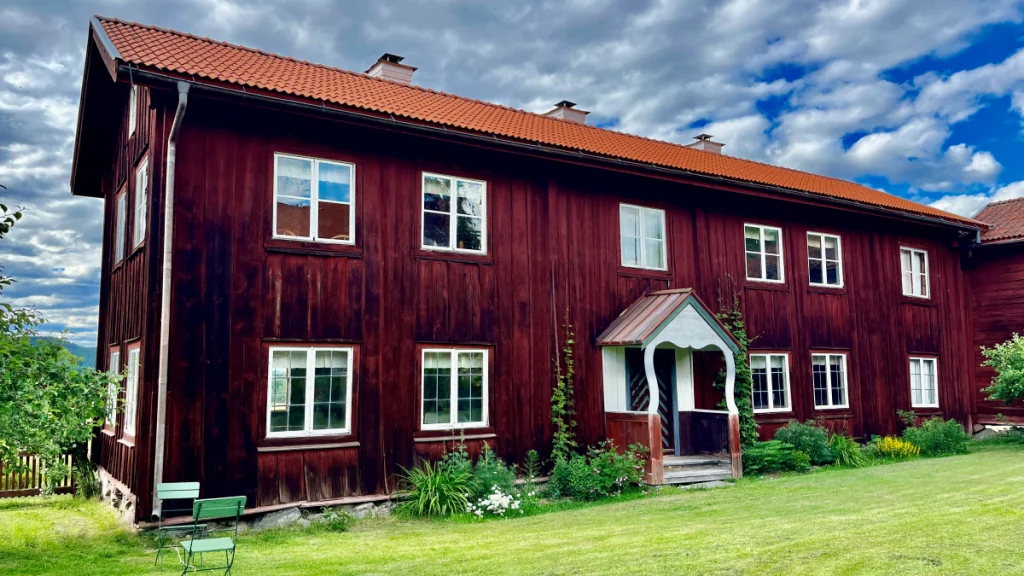
The history of the farm in brief
Kristofersgården was moved to the site in the early 1800s, but has roots that go back a long way and has been farmed by the same family for at least 14 generations. The old building at Kristofers was built in 1807, making it Hälsingland's oldest two-storey farmhouse.
Especially worth seeing on this farm
The farm is known for its interior paintings by Ljusdal painter Anders Ädel, dating from 1854. The most fascinating are the large paintings in the manor house, with exotic motifs such as swaying palm trees. However, given that the palm trees are slightly different from what palm trees usually look like, it is conceivable that the artist never saw palm trees in real life.
The room also features a painting of the 'All-Seeing Eye of God', which can peer down on the wedding guests or party participants.
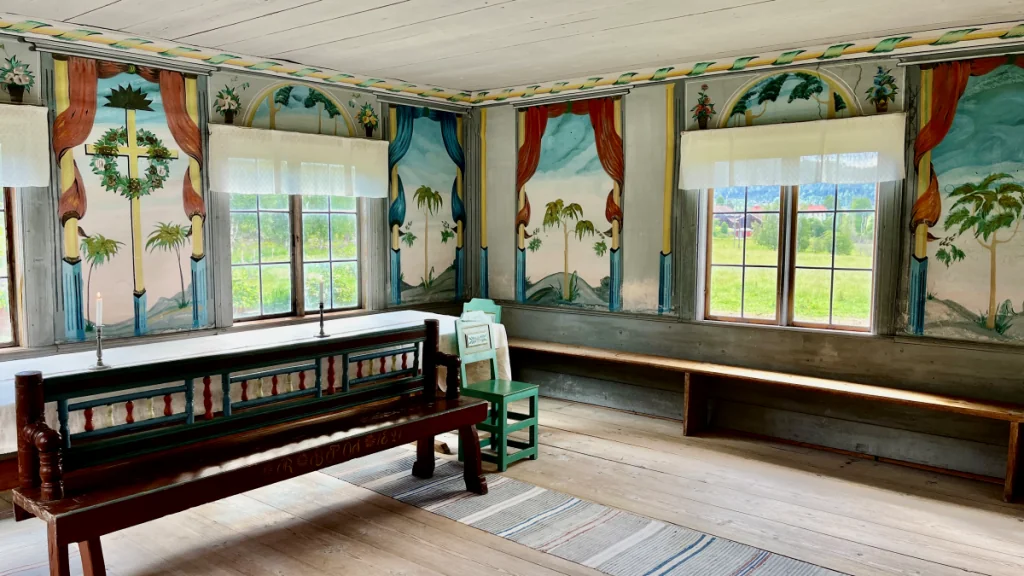
Visiting the farm
Kristofers felt almost "hardest" to visit, as the farm is run as a private farm, and as no public tours are given. However, we managed to book a tour, early one evening, and were shown around by Stephanie who lives on the farm with her husband. It was a very interesting visit, with a personalised and enjoyable tour.
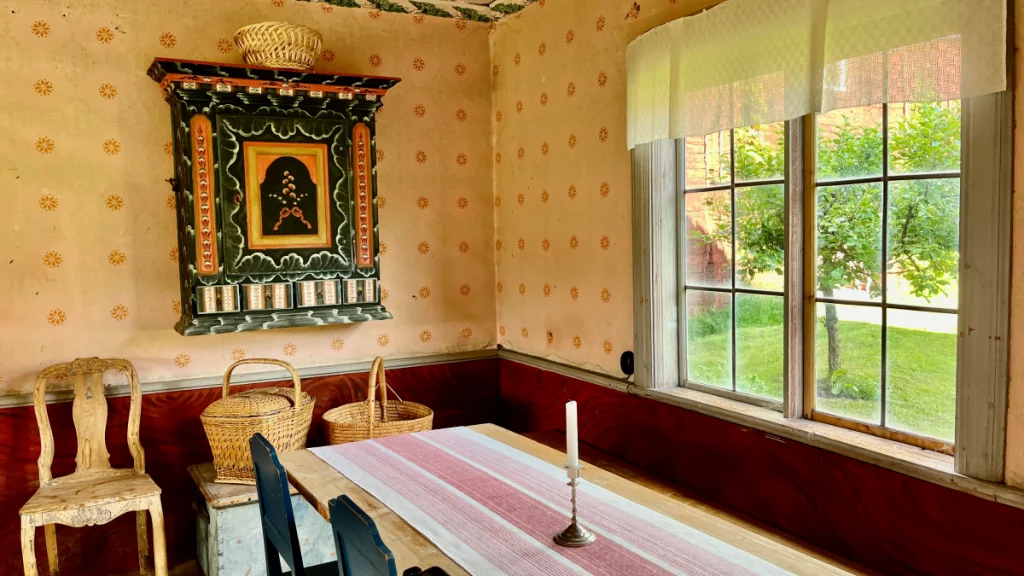
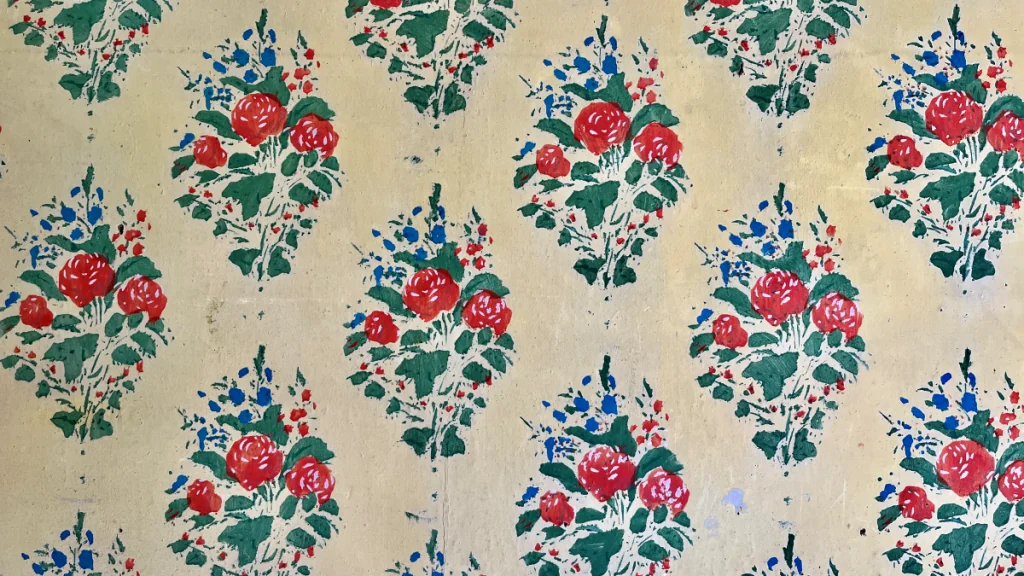
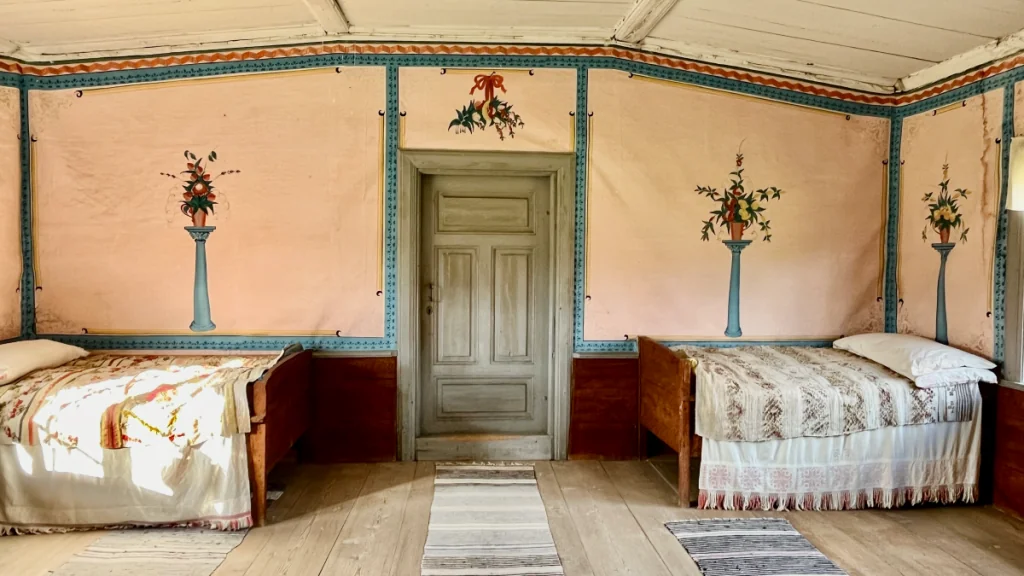
- Address: Kalvstigen 6, Järvsö
- Opening hours: No general opening hours. The farm is a living farm with forestry and agriculture. If you would like to see the privately owned farm, please call to see if you can book an appointment.
- Guided tours: Guided tours are available by appointment.
- Price: For guided tours: 600 SEK/person (Price valid for 2024)
- Service: Accommodation and meat sales
- Website: kristofers.se
4. bommars
Hälsingegården Bommars is located in Letsbo, just outside the centre of Ljusdal. This beautiful farm is also privately owned, but it is possible to contact the owner and book a viewing. Expect both coffee and fantastic wallpaper!
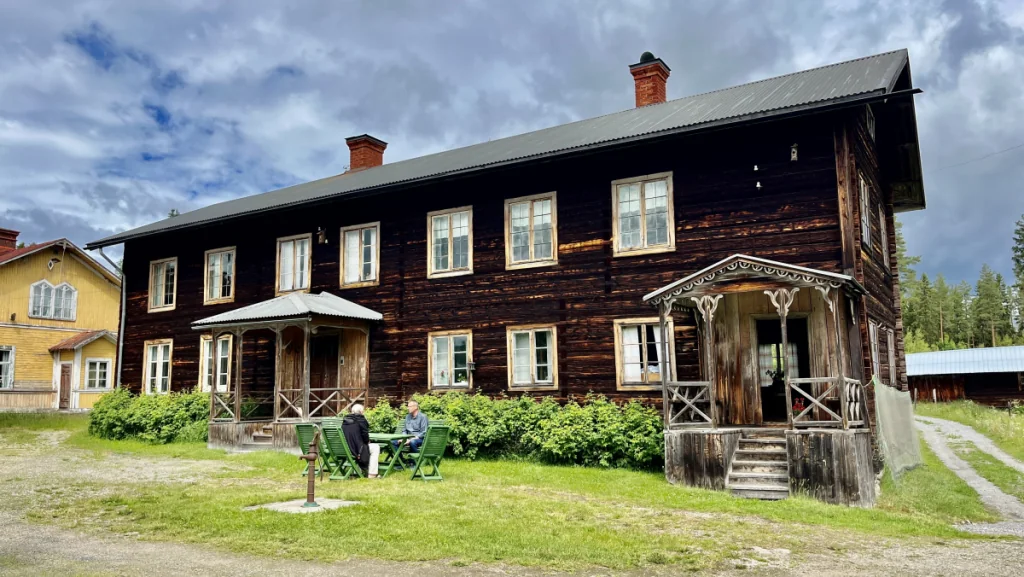
The history of the farm in brief
The Bommars farm has a long history, but most is known from the time after 1540, as that was when taxes began to be assessed and things were written down. The whole farm burned down in 1845, and the building that stands here today dates from 1846. Thanks to the flax, and also the forest, they were well off and could put effort into the banqueting rooms.
Especially worth seeing on this farm
The houses have original furnishings dating back to 1848. They include beautiful manor-inspired wallpapers, which have been combined with folk painting. In one of the rooms, the painter has copied a French wallpaper, which is also found in the Ekebyhof manor house in Stockholm, and given it a unique look by covering the joints with stencilled paper strips.
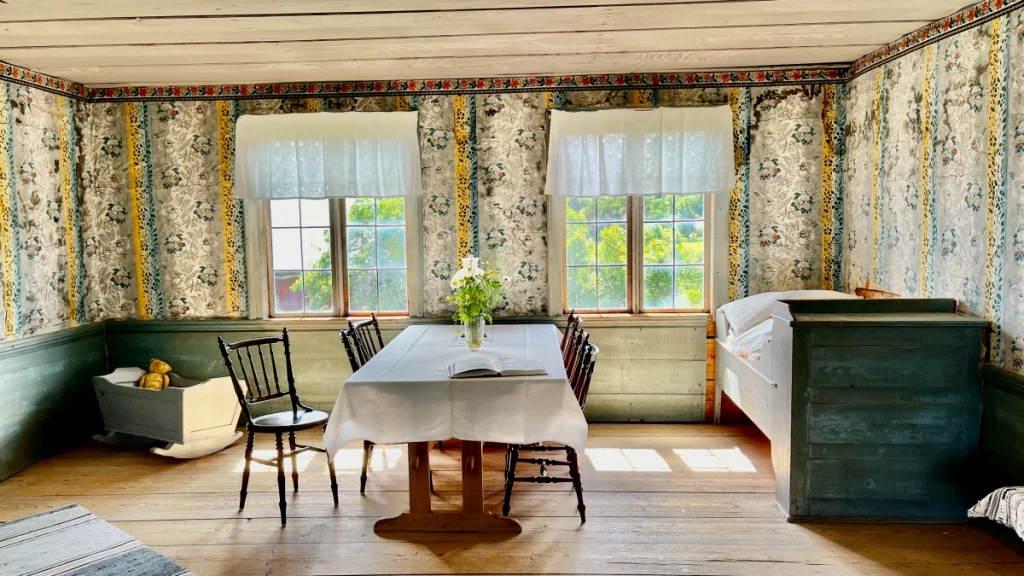
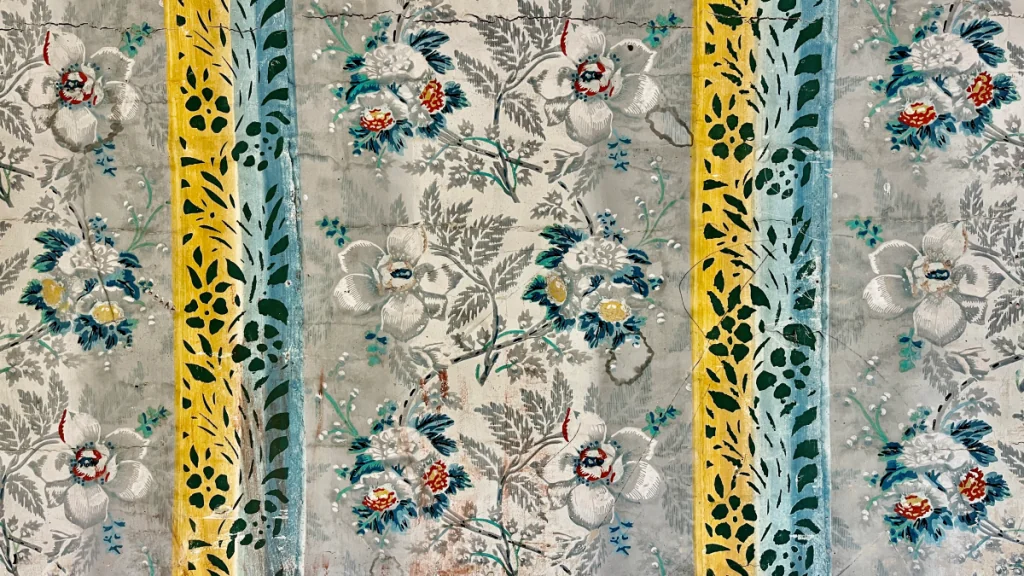
Bommars also has marbling and veining paintings and a wide range of tools from the past. We also found it exciting to see the rooms lined with newsprint, as this was considered exclusive at the time. You can spend a lot of time there reading old articles and adverts!
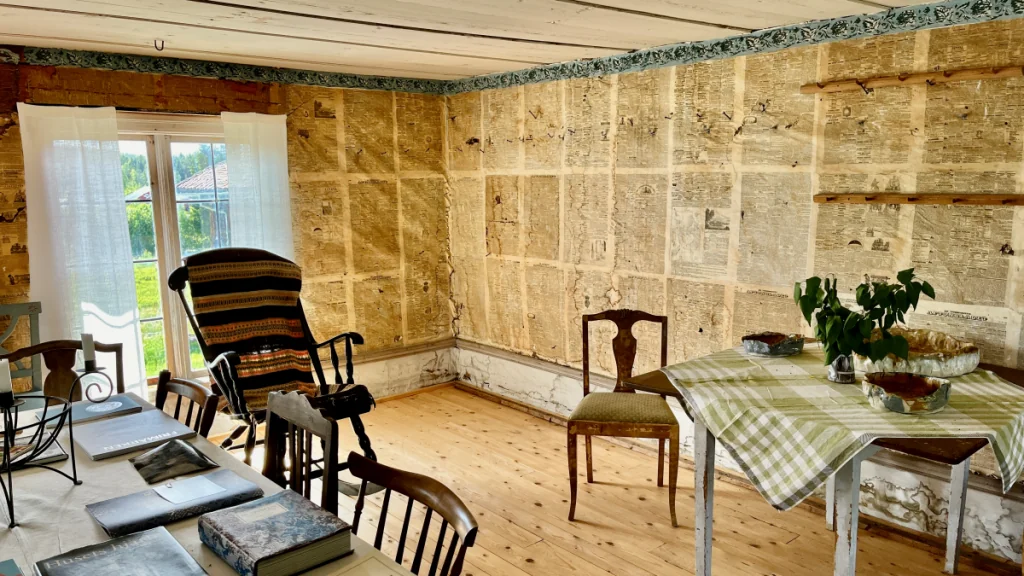
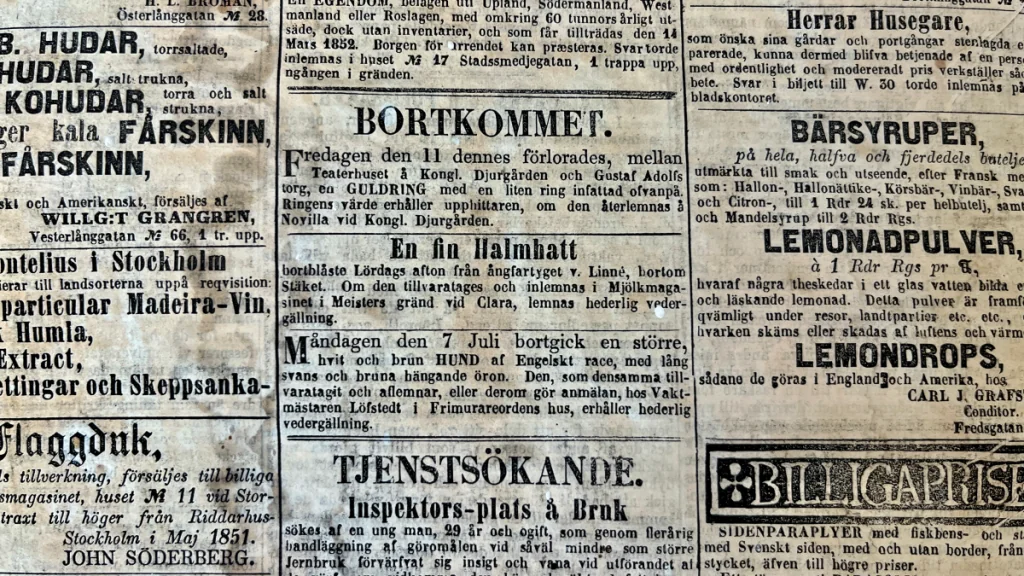
Visiting the farm
Visiting Bommars requires a bit of planning as the visit must be booked in advance. Once you have booked an appointment, it is easy to visit. The owner, Karl-Erik, is very knowledgeable about the farm and its history and has a lot to tell. In addition, it was nice to start the visit with coffee and dip!
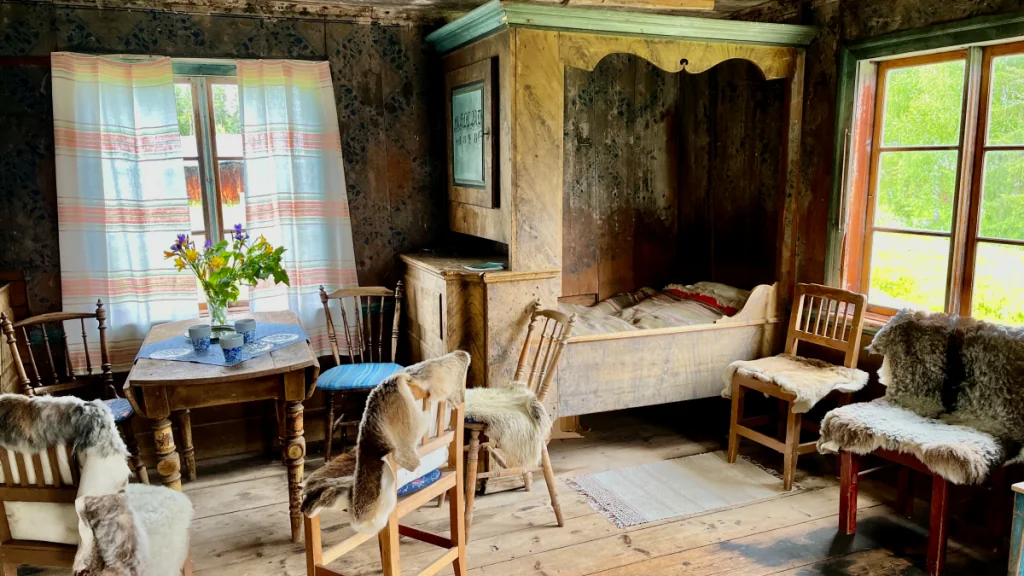
- Address: Letsbo Brovägen 8, Tallåsen
- Opening hours: Guided tours can be organised in summer. All visits must be pre-booked.
- Guided tours: A guided tour is booked via the farm owner Karl-Erik.
- Price: Guided tour: 300 SEK/person (coffee included). Free for children under 16 (price valid for 2024)
- Service: Coffee is included in the guided tour.
- Website: bommars.se
5. Beyond the river
Bortom Åa is the name of the old farm in Fågelsjö, on the border between Hälsingland, Härjedalen and Dalarna. This farm is open to visitors in the summer, and here you can see both beautiful stencils and a very special hearth equipped with seven locks.
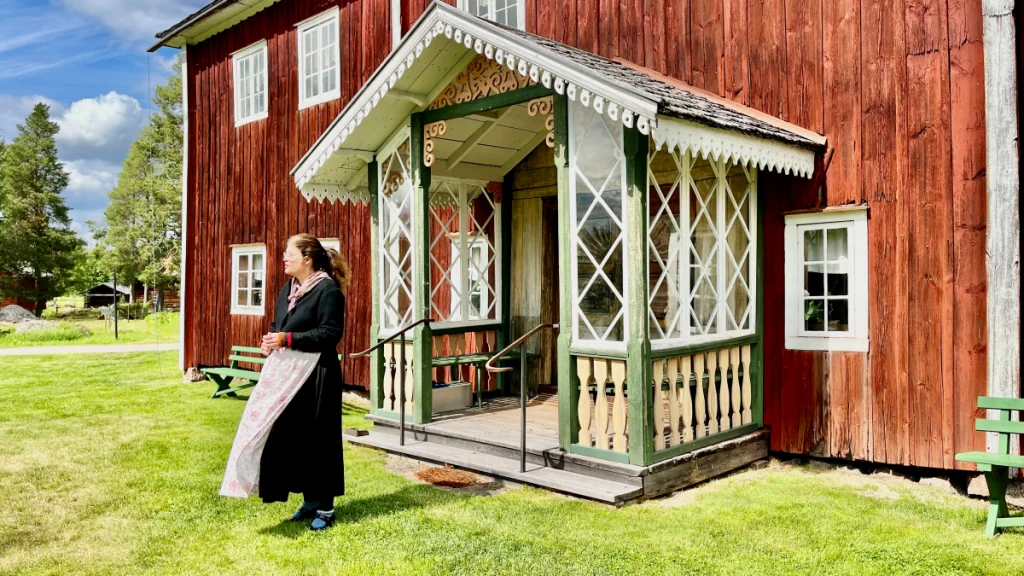
The history of the farm in brief
Fågelsjö Gammelgård is a well-preserved farm dating back to the Finnish
immigration in the 17th century, in a village on the border between Dalarna, Hälsingland and Härjedalen. The farm includes various buildings such as a hearth, a baker's cottage and a gunsmith's shop.
The farm has been owned by a single family for seven generations, and has of course changed during this time. The couple Mårten and Kristina lived in Gammelgården until 1910, when they moved to the newly built residential house. This house was built after a picture on a postcard from relatives in America and was named "Amerikahuset".
Especially worth seeing on this farm
When the family moved into the new home, they left the old farmhouse exactly as it was, furnishings and all, making this one of Sweden's most well-preserved 19th-century farmhouses.
The courtyard also contains the 'seven-lock armoury', i.e. a food store with seven locks. Apart from the fact that the food was preserved, this shows that the owner, who had great expertise in the art of blacksmithing, placed great value on developing this advanced locking device.
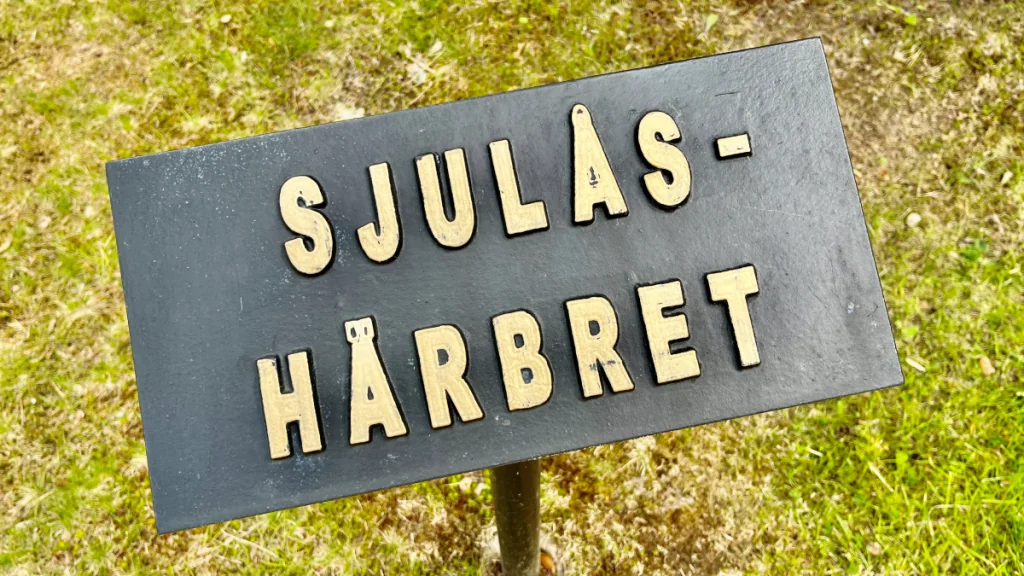
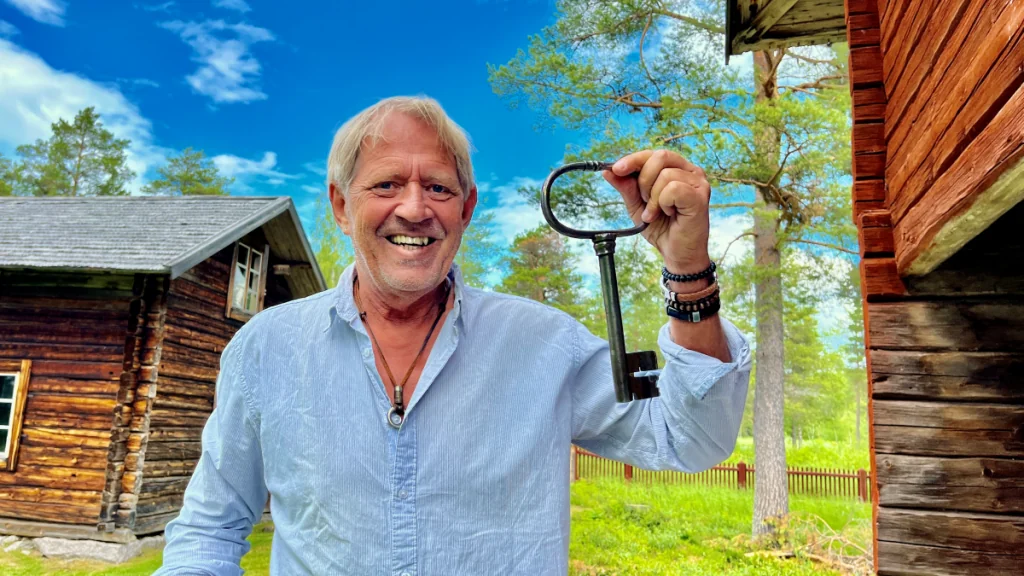
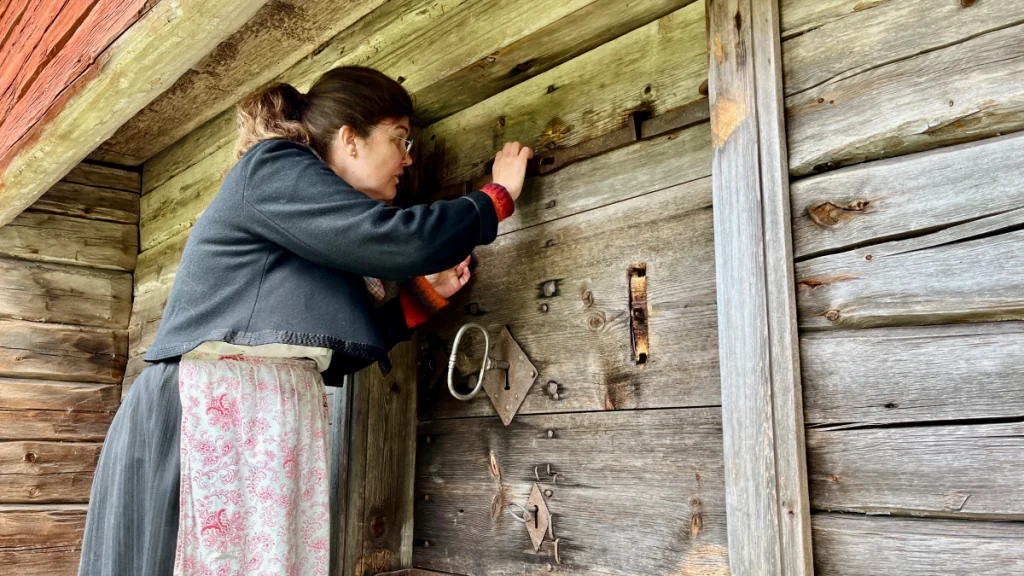
Visiting the farm
Visiting the Hälsingegården Bortom Åa is relatively easy, as the farm is open to visitors in summer. There is also a café and a small museum, and if you want you can stay overnight with your campervan. In other words, this is a nice place to visit!
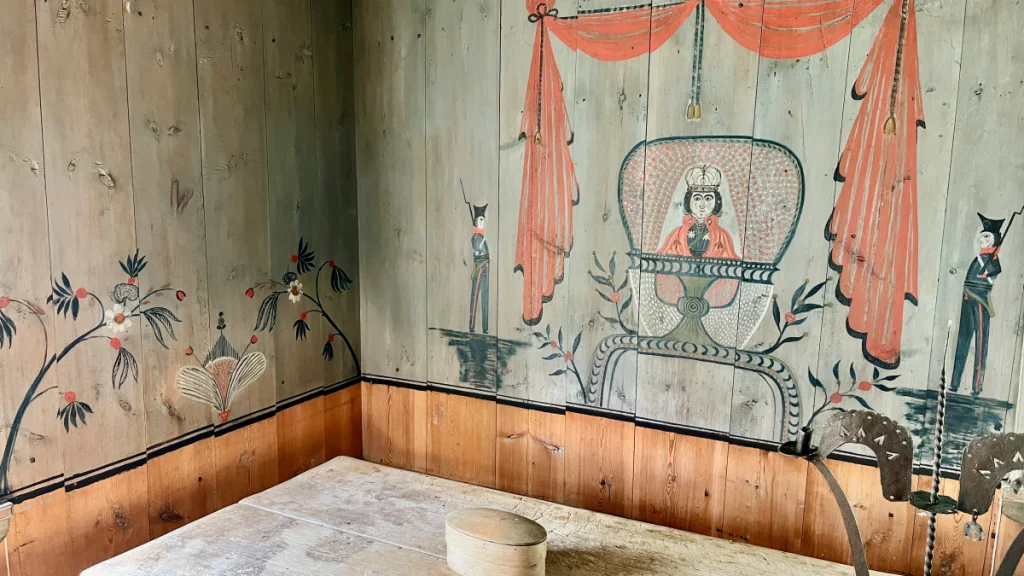
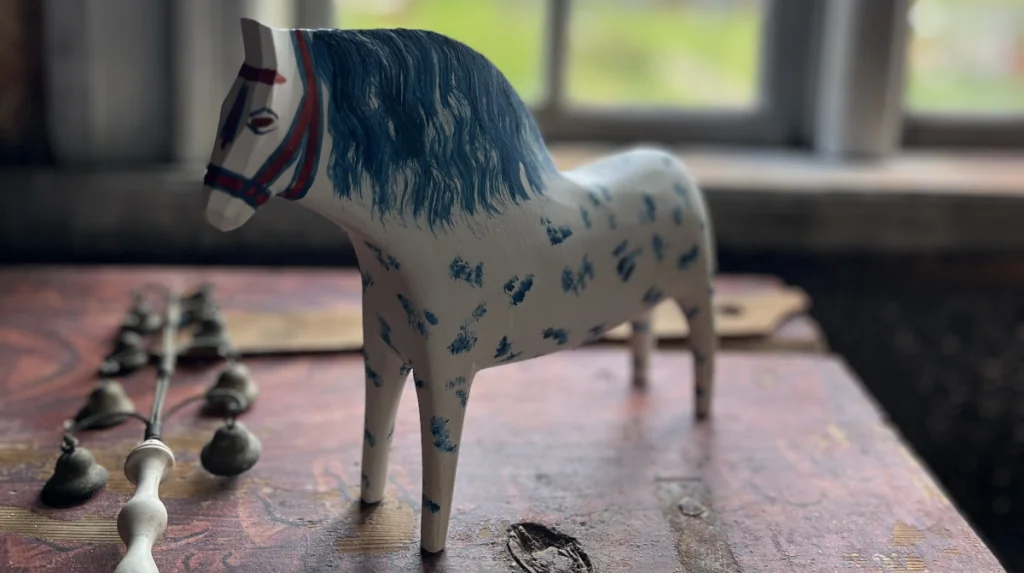
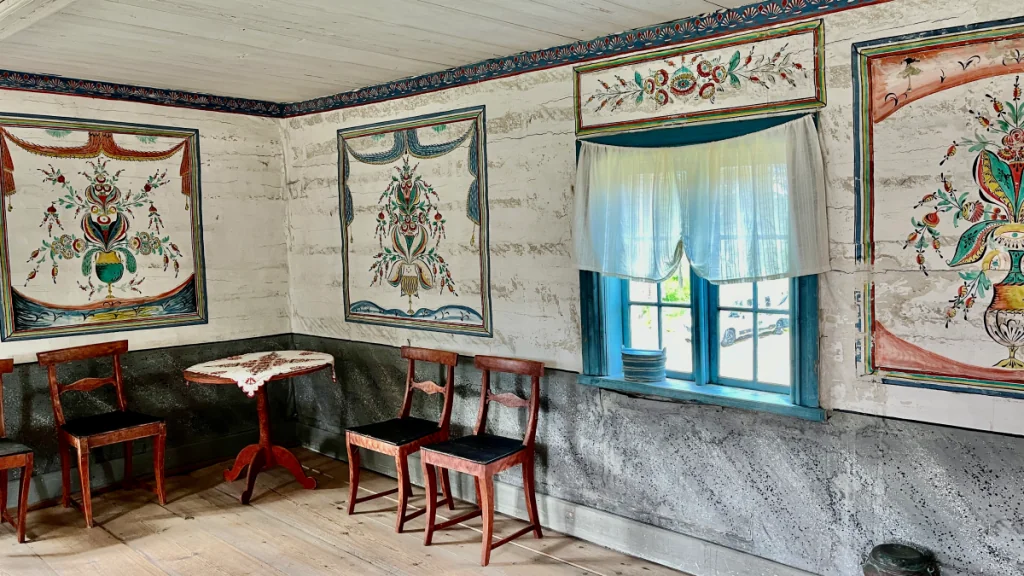
- Address: Fågelsjö Gammelgård Beyond Åa, Loos
- Opening hours: Open to the public in summer. 2024: 1 June - 8 September, 10:00 - 17:00.
- Guided tours: Guided tours are given at certain specific times, during opening hours. See the farm website for exact times.
- Price: Guided tour: 160 SEK/person (Price valid for 2024)
- Service: Café, museum, accommodation and caravan park.
- Website: www.fagelsjo.nu
6. pallars
Pallars in Långhed is one of two Unesco farms in the small town of Alfta, in Ovanåker municipality. Together with the other farm - Jon-Lars - they have agreed on tour times so that you can see both farms on the same day.
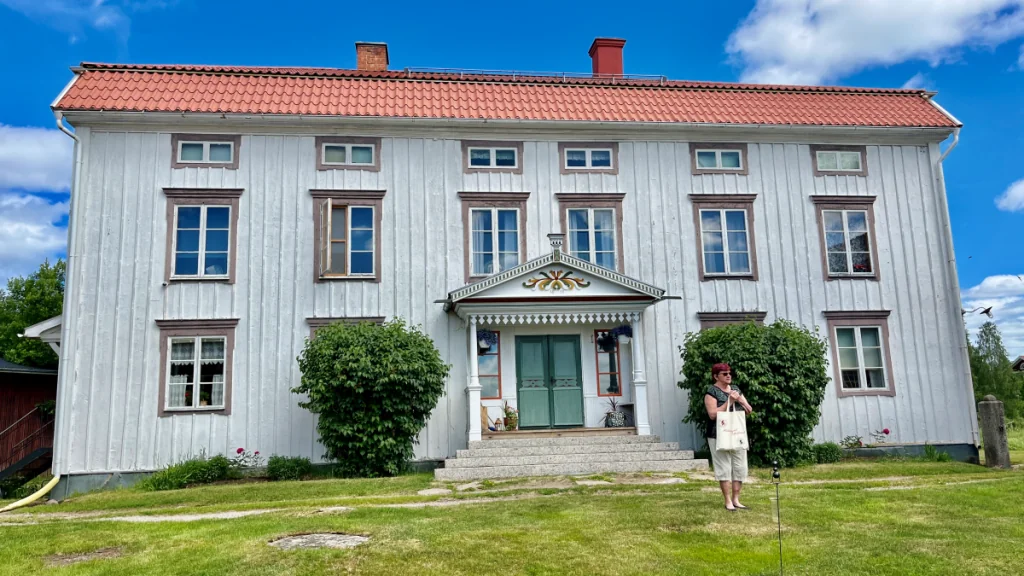
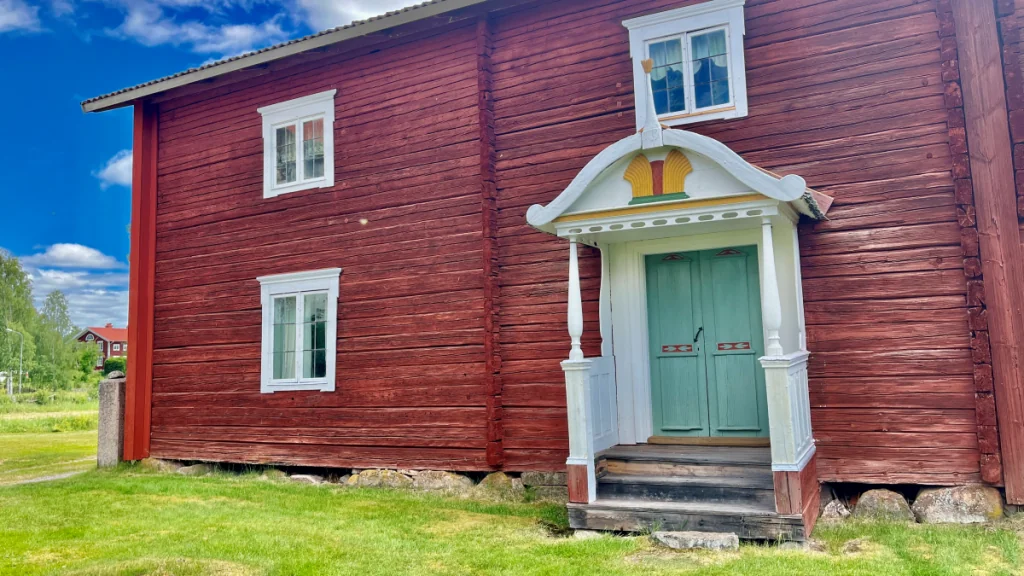
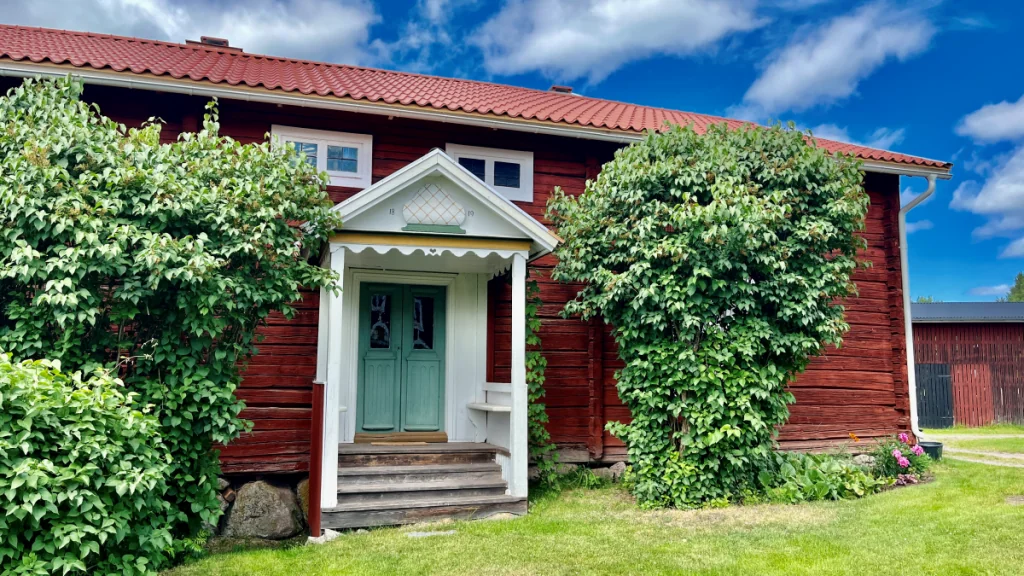
The history of the farm in brief
Pallars, located in Alfta parish, is a large and beautiful farmhouse with an unusual number of cobblestones and carved doors. The large white dwelling house was built in 1858, while the east wing is thought to date from the 18th century. The farm, which is privately owned, has been in the same family since the 17th century.
Especially worth seeing on this farm
In one of the wings there are very special paintings made by the so-called "Blue Painter". Known for his use of a precious navy blue pigment, there are paintings depicting different places in Sweden.
That the image of "Stockholm" is not very similar to Stockholm may be because the artist has never visited the capital, but you can see that he has heard of various places that he has tried to depict. It is also interesting that some parts are unfinished, and that other parts are, to say the least, echo-y. Perhaps the artist and the client disagreed, so that the artist finished too early and also chose to add "inappropriate" elements?
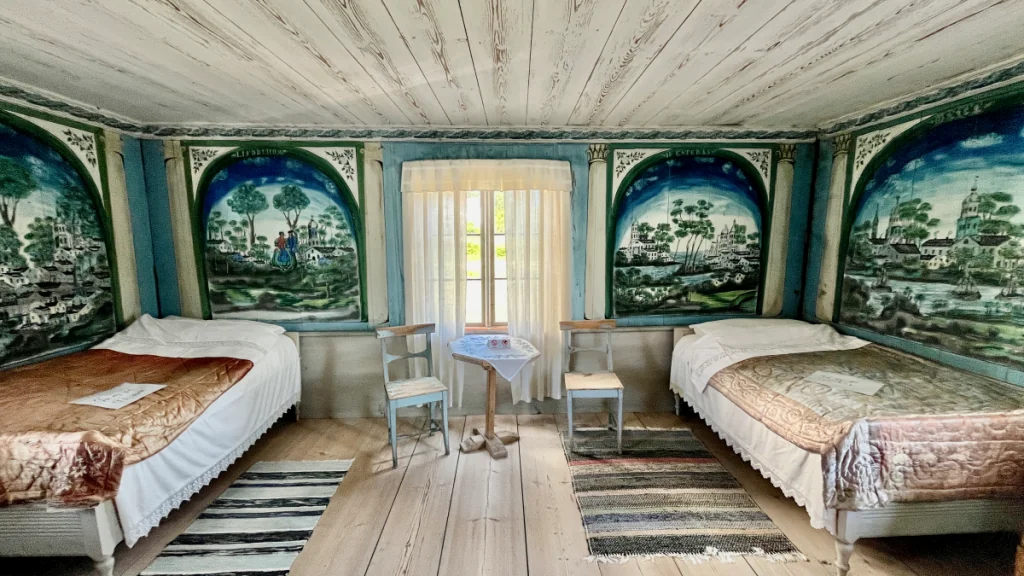
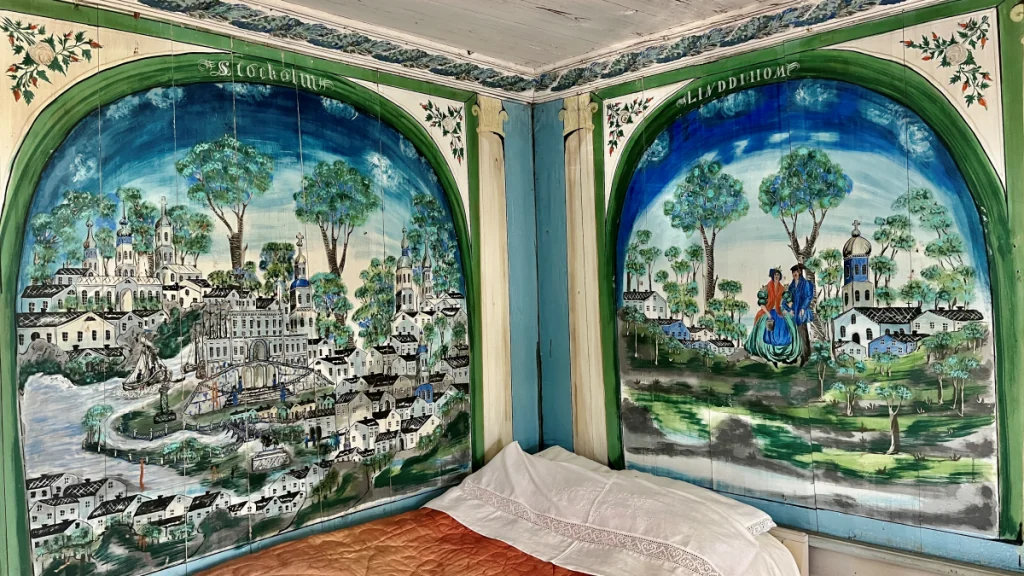
Visiting the farm
The farm is visited by taking the guided tours, which are advertised on the municipality's website. Once there, you can expect an interesting guided tour and an exciting visit. Please note that the large white farmhouse is not shown inside, but that the tour is done in the two wings.
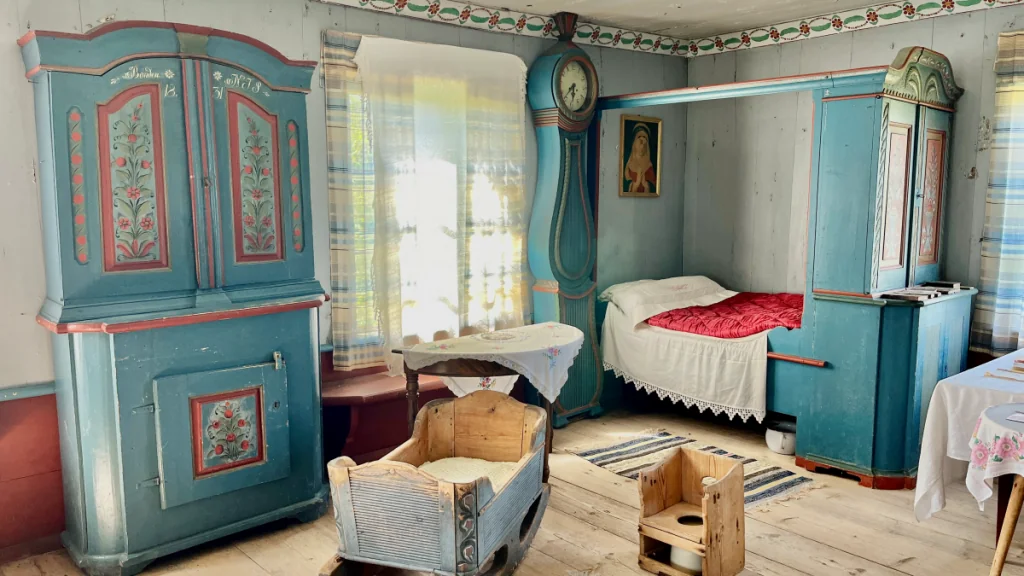
- Address: Långhed 739, Alfta
- Opening hours: The farm is privately owned, and can only be visited at the times when tours are given. 2024: Daily tours at 12.00 between 24 June and 11 August.
- Guided tours: Guided tours are given at advertised times.
- Price: For guided tour: 230 SEK/person (Price valid for 2024)
- Service: None
- Website: No specific website available. See the Ovanåker municipality website.
7. Jon-Lars
The other farm in Alfta, Jon-Lars, is a very large farm with two identical halves, designed for two brothers and their families. There are both modern parts, where the current owners live, and well-preserved parts with furnishings and paintings from the past.
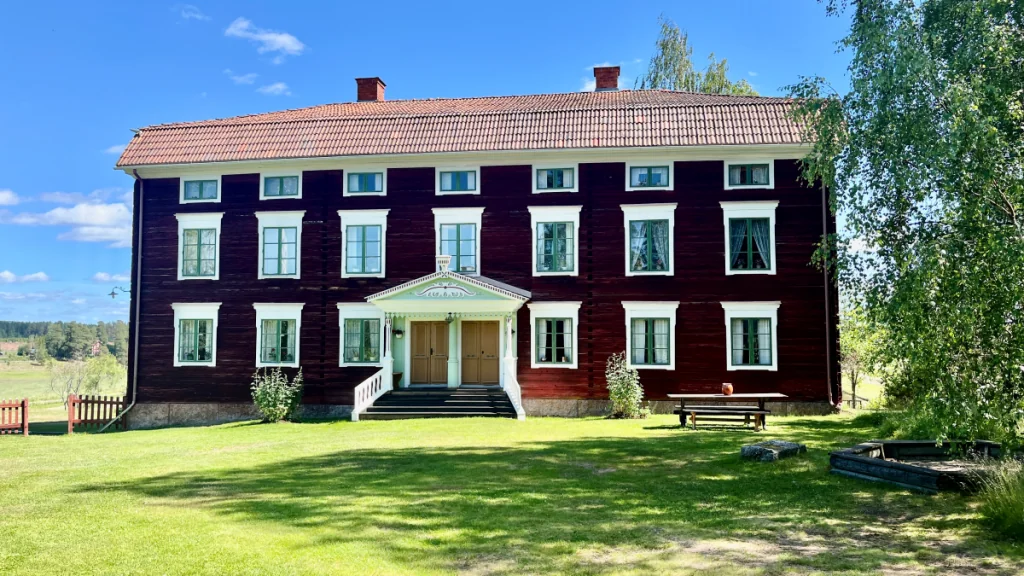
The history of the farm in brief
The Jon-Lars farm in Långhed boasts the largest building among Hälsingland farms. The dwelling house, which began construction in 1853, was created for the two brothers. One half has been continuously inhabited and therefore renovated several times, while the other half is very well preserved.
Especially worth seeing on this farm
The most special thing about the Jon-Lars farm is that it's built in two halves, with a common manor house for parties. It is also interesting that the two parts are decorated in different styles. One part is painted with blue and pink landscape views, signed by the valley painter Svärdes Hans Ersson, while the other part is decorated with French wallpaper.
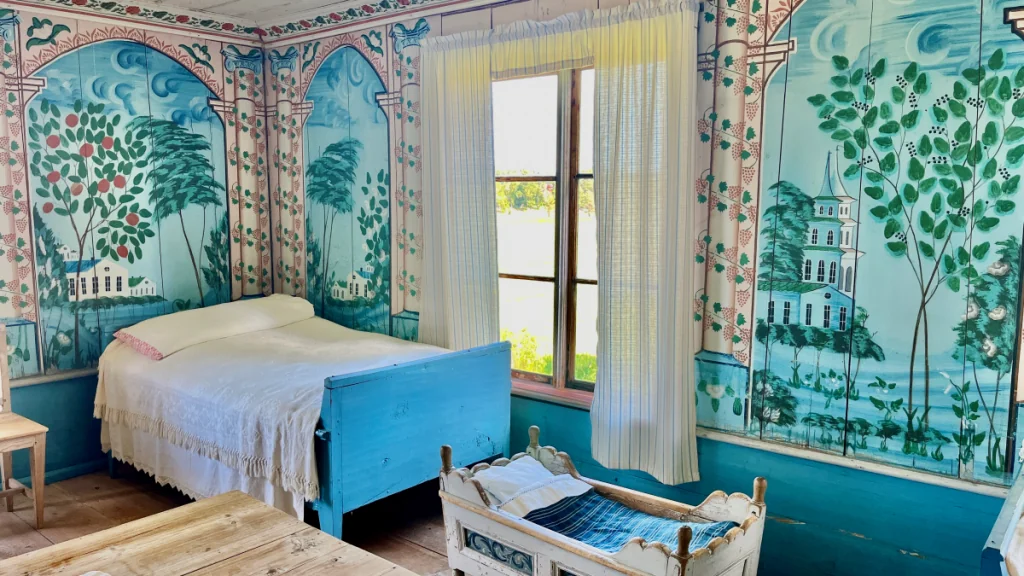
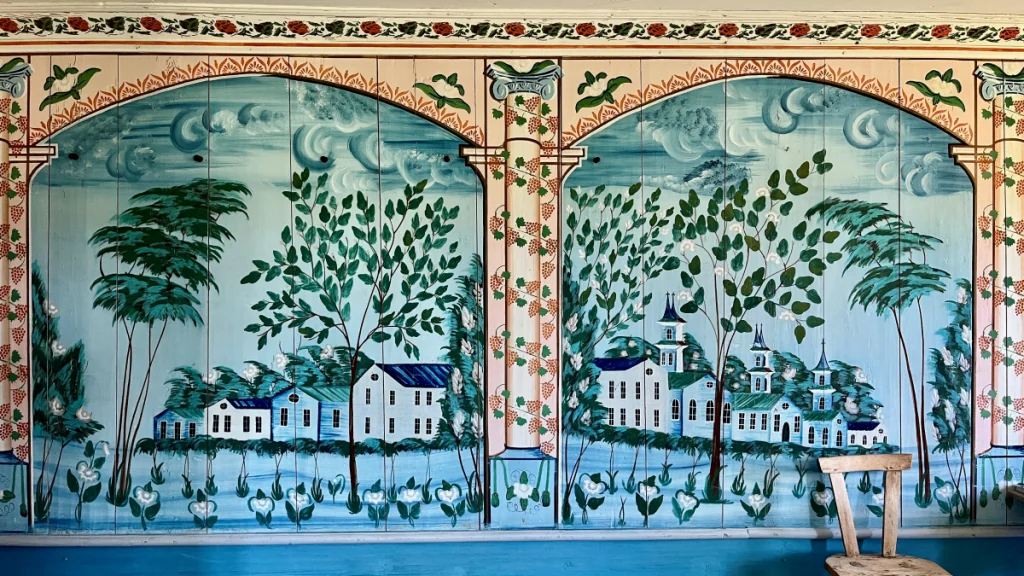
Visiting the farm
The farm is visited by going on the guided tours, which are advertised by the municipality. Once you are there, it is a very interesting tour and an exciting visit!
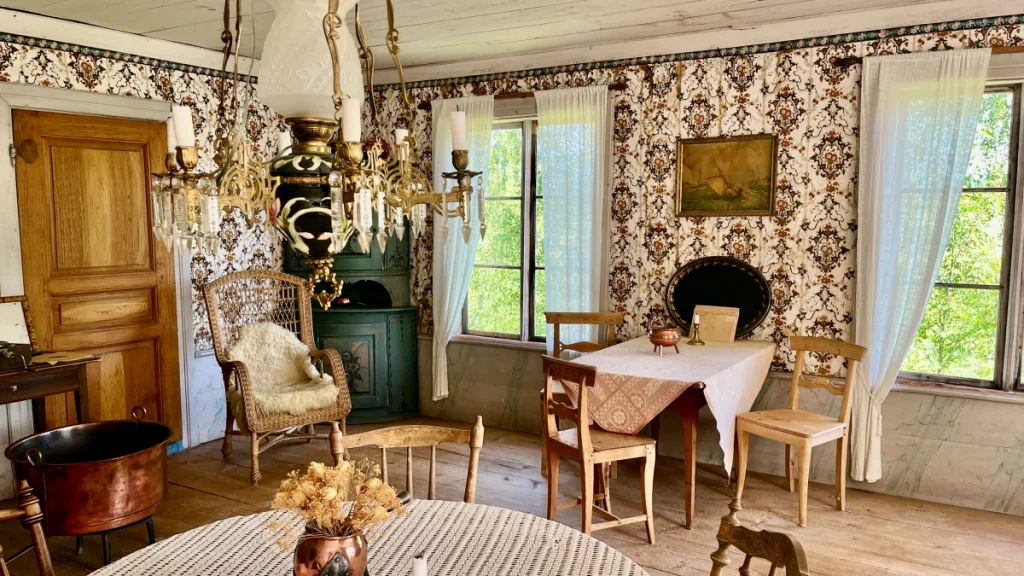
- Address: Långhed 206, Alfta
- Opening hours: The farm is privately owned, and can only be visited at the times when tours are given. 2024: Daily tours at 13:30 between 24 June and 11 August.
- Guided tours: Guided tours are the only way to see the farm.
- Price: 230 SEK/person (This price is valid in 2024)
- Service: None
- Website: No specific website available. See the Ovanåker municipality website.
Visiting Hälsingland farms - on film
Peter filmed our visit to the seven Hälsingland farms inscribed on the UNESCO World Heritage List, and you can watch the film here:
Visiting Hälsingland farms - four visitor centres
A good starting point for visiting Hälsingland farms is to go to one of the four visitor centres. At the visitor centres you will find information, brochures, staff to talk to and much more.
Erik-Anders in Söderhamn
Hälsingegården Erik-Ander in Söderhamn, which is one of the World Heritage Farms, also serves as a visitor centre. Here you'll find brochures, a shop and café and, yes, one of the World Heritage Farms!
Guest hosts in Vallsta
Gästgivars in Vallsta also functions as both a World Heritage Site and a visitor centre. Here you will find information, brochures, shop, exhibitions and much more.
Stone farm in Järvsö
Stenegård is a visitor centre for the world heritage farms, conveniently located in the middle of popular Järvsö. Here you will find information about the different farms and some exhibitions. At the same time, you can take the opportunity to discover beautiful Stenegård!
Ol-Anders in Alfta
The fourth and final visitor centre for the World Heritage Farms is Ol-Anders in Alfta, which is very close to Pallars and Jon-Lars. Here you will find, besides information about the World Heritage Farms, also a very interesting emigrant museum.
This museum tells the story of the people of Hälsingland who emigrated to America early on, for religious reasons. Nearby, you can also check out the Ol-Anders farm, which is beautifully decorated.
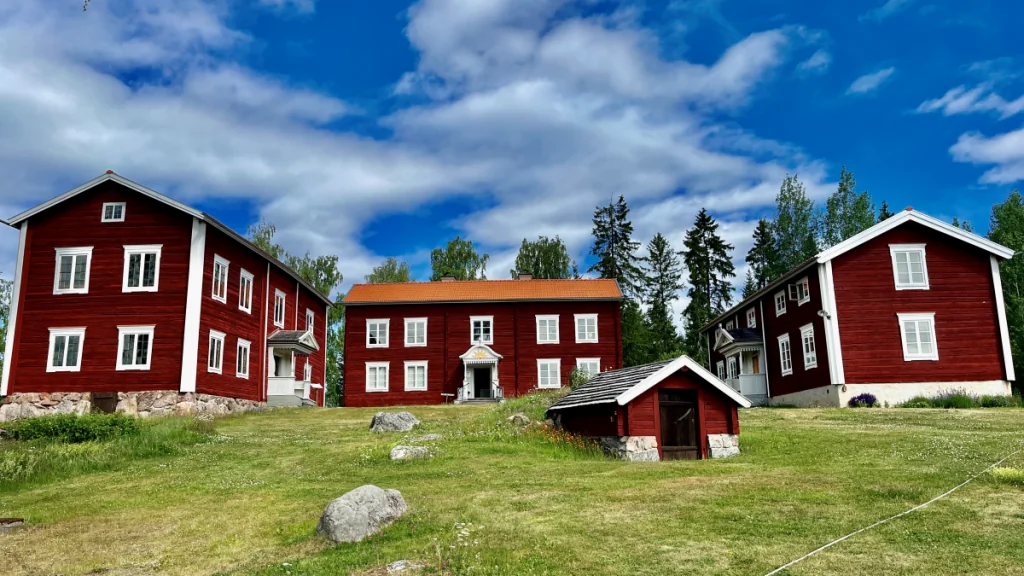
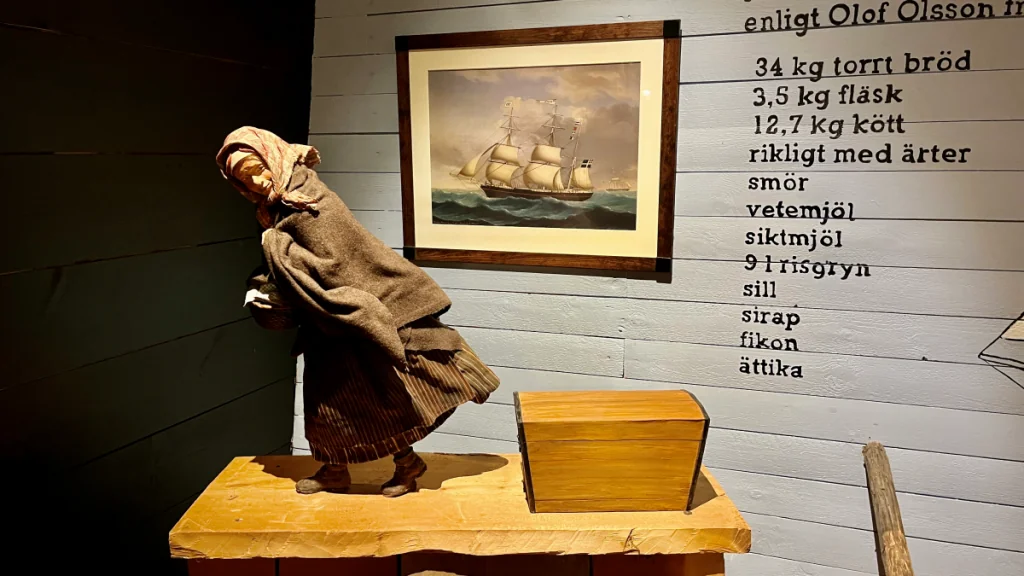
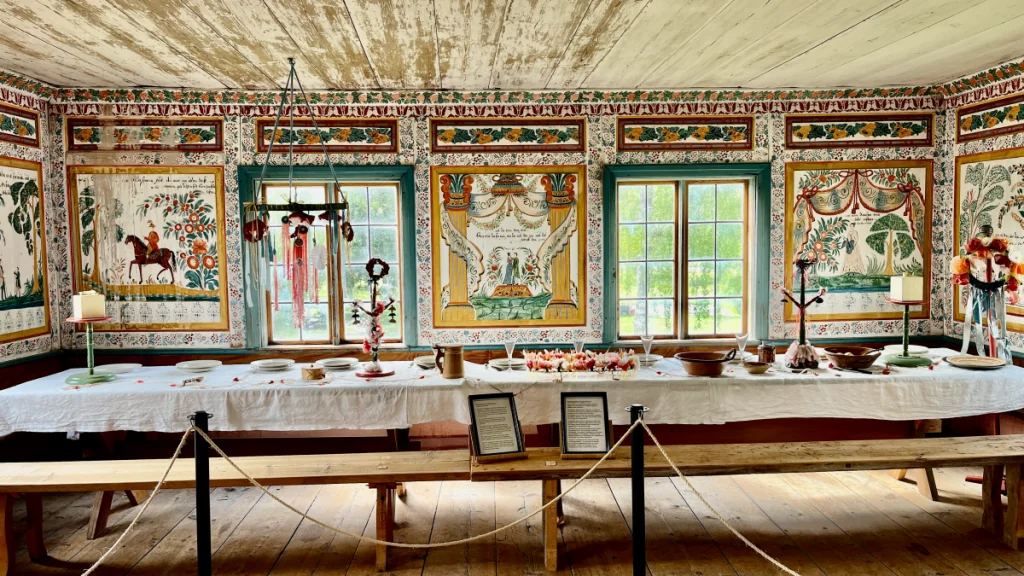
Visiting Hälsingland farms - The Great Hälsingland Farms Route
Another way to visit Hälsingland farms is to travel along the Stora Hälsingegårdars väg. This tourist route winds past a long line of large and magnificent Hälsingland farms. However, it is not the case - as we first thought - that the road takes you past the farms on the UNESCO list.
Instead, you can experience and visit many other fine Hälsingegård farms. The road, which is 28 kilometres long, starts at Hälsingegård Ol-Anders in Alfta and ends at the Mårtes farm in Edsbyn. The road passes:
- Hälsingegård Ol-Anders
- Alfta church village and community
- Hälsingegård Onion
- Näsbyn and Långhed
- Vängsbo Linskäkt
- Kneading
- Red Mountain
- Ullungsfors
- Hälsingegård Mårtes
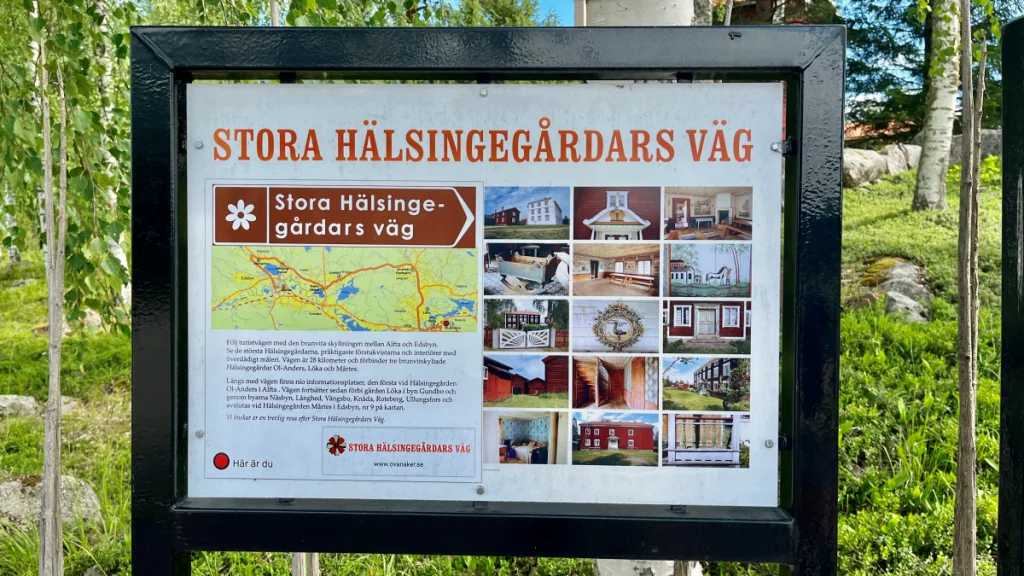
Visiting Hälsingland farms - more farms and activities
There are many ways to visit Hälsingland farms. In addition to guided tours of the world heritage farms, visitor centres and the Great Hälsingland Farm Trail, here are a few more tips. You can also read more and get up-to-date information at Destination Hälsingland's website.
Open health farms
Open Hälsingland farms are farms that occasionally, mainly in summer, are open to visitors with various activities. Here are examples of such farms:
- Bjuråkers Forngård, Hudiksvall
- Delsbo Forngård, Hudiksvall
- Frägsta Hälsingegård, Näsviken, Hudiksvall
- Stone farm in Järvsö, Ljusdal
- Träslottet, Bollnäs
- Ystegårn Café and Bistro, Hudiksvall
Stay at Hälsingegård
A special experience can be to not only visit a Hälsingland farm, but also to stay on one. Some farms offer this possibility, such as for example:
- Erik-Jons, Edsbyn-Alfta
- Frägsta Hälsingegård, Näsviken, Hudiksvall
- Köpmangården Pallars, Älvkarhed, Edsbyn-Alfta
- Mårtens, Edsbyn-Alfta
- Per-Anders, "Lammkatedralen", Långhed, Edsbyn-Alfta
- Träslottet, Bollnäs
Events at Hälsingegård
Some Hälsingland farms organise various events, especially in summer. Here are some examples:
- Fäbod Week
- Hälsingehambon
- Midsummer celebrations
- Summer stage at Ystegårn, with various artists
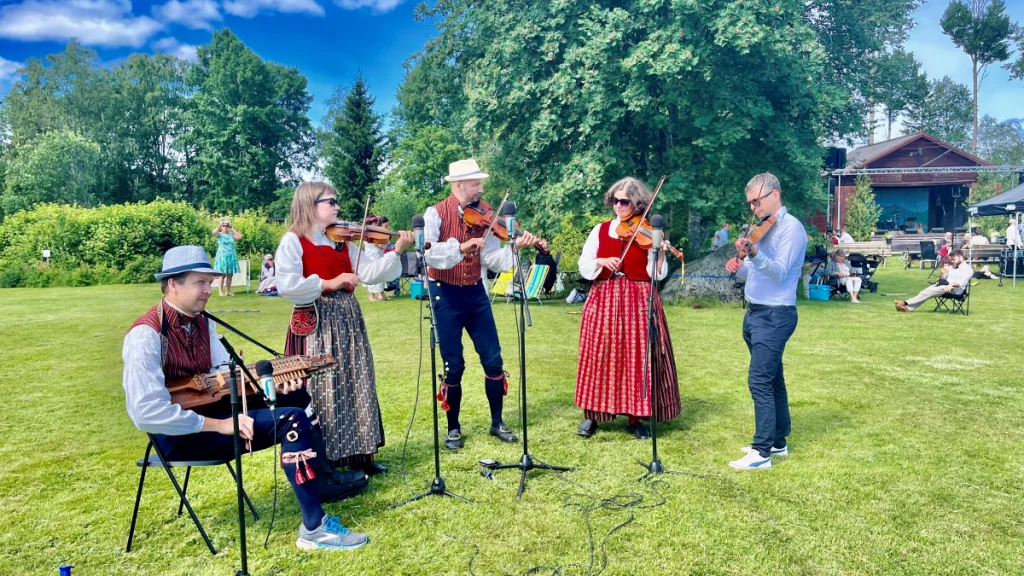
Visiting Hälsingland farms - which ones can you recommend?
Have you ever had the chance to visit a Hälsingland farm? Maybe one of the seven Unesco farms, or one of all the others... Which one(s) can you recommend?
visiting hälsingegårdar - facts and info
What is a Unesco World Heritage Site?
The UNESCO World Heritage List was created to protect the world's greatest natural and cultural heritage from destruction. The World Heritage Convention was adopted by UNESCO in 1972 and has now been signed by around 200 countries. To be designated a World Heritage Site, the site must have 'universal value', which means that the natural or cultural values of the site are considered to be of concern to all people in the world.
Hälsingegården World Heritage Site
The World Heritage Site of Hälsingegårdar was inscribed on the World Heritage List under the name "Decorated Farmhouses of Hälsingland" in 2012, making it Sweden's 15th World Heritage Site. What is unique about Hälsingegårdarna is that the farmers of Hälsingland built so many and such large party houses, and that the decorated interiors have been so well preserved.
The rationale for the World Heritage designation
"The large, imposing Hälsingland farms with their richly decorated banqueting rooms reflect a unique combination of timber construction and folk art tradition, the wealth and social status of the independent farmers who built them, and represent the culmination of a long tradition in Hälsingland."


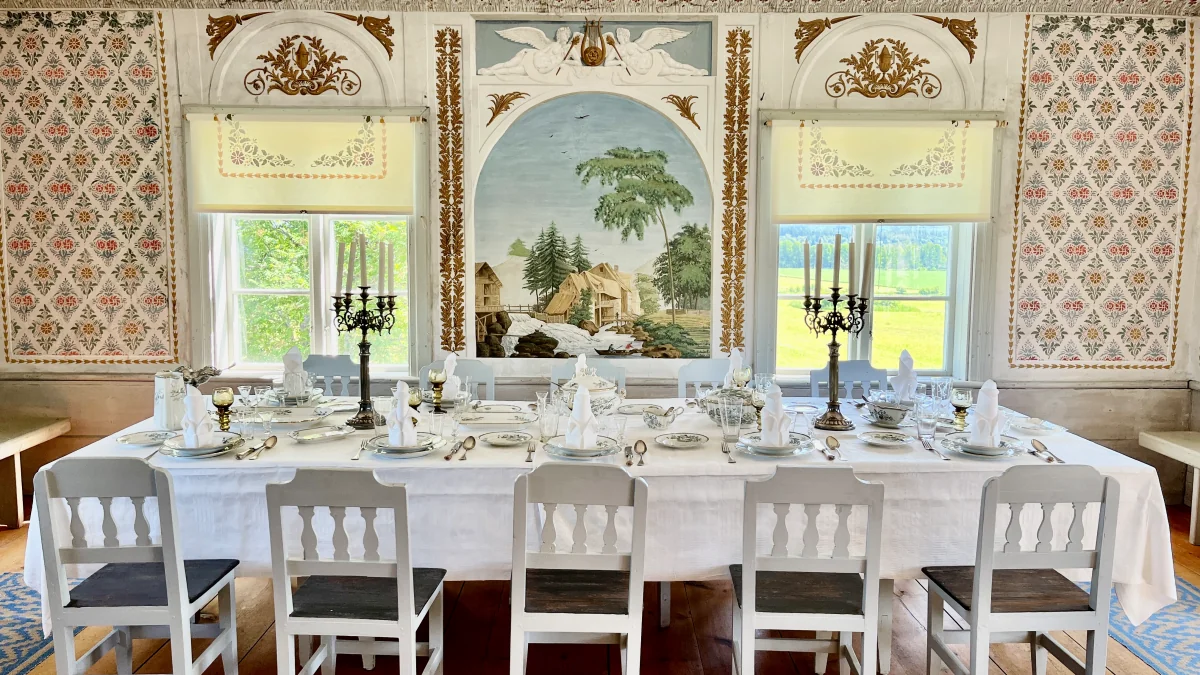






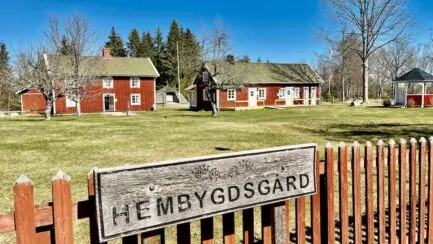
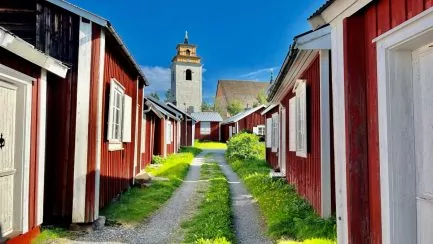
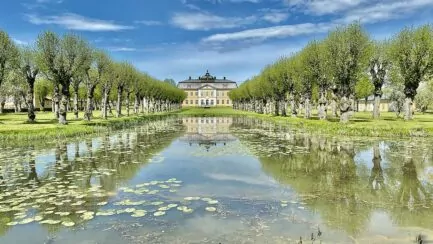
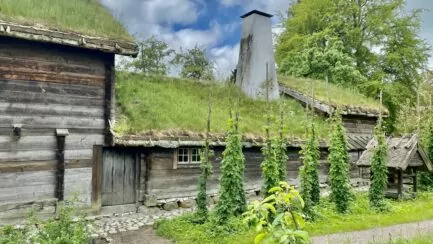
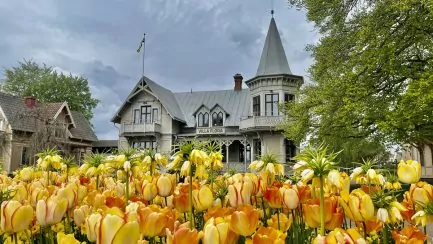



JoY says:
Thank you for a very nice post you have made of these nice farms. Nice with the film, got a different impression of the farms with it.
We haven't visited any farms, haven't even thought about it, but now we've got some good tips from you.
30 June 2024 - 16:18
Helena says:
We're glad you enjoyed our post! And the film! 🙂 Hälsingegårdarna is well worth a visit!
30 June 2024 - 19:24
Frido says:
What an incredible report! Wow! I can't believe you got to everyone!
30 June 2024 - 19:17
Helena says:
Thanks for your comment! We have worked a lot to get this report 😉 Glad if it is appreciated!
30 June 2024 - 19:25
bmlarstravellingblog says:
What a nice post about the beautiful Hälsingland farms. We'll keep it for our next visit to Hälsingland, although we won't be so ambitious as to visit them all. Nice film!
Have a good time on the road around Siljan where there is so much beauty!
30 June 2024 - 19:22
Helena says:
I'm glad you like it! You don't have to visit all of them, but it's really worth seeing some of them! Incredibly beautiful, and with exciting history!
30 June 2024 - 19:26